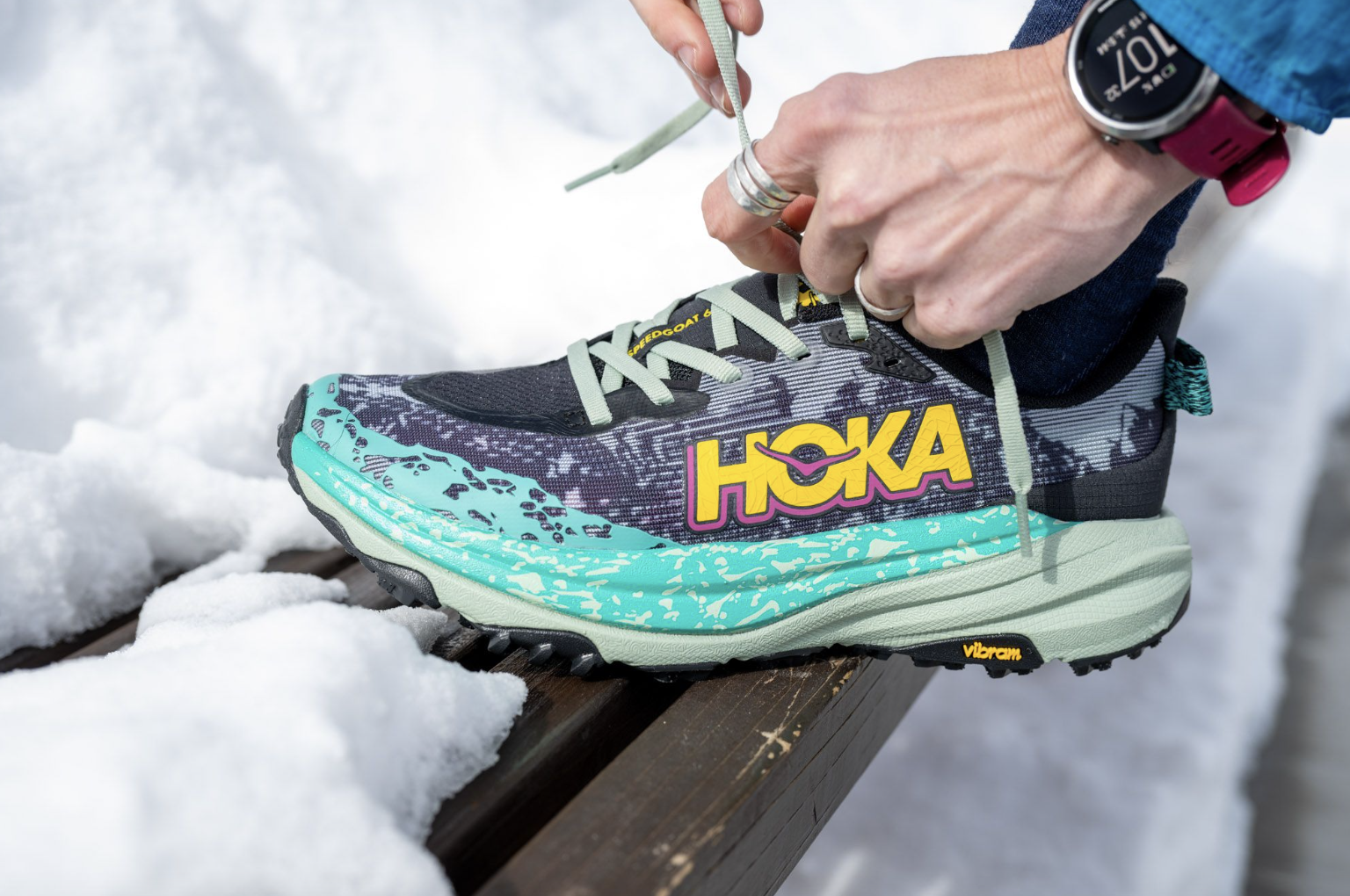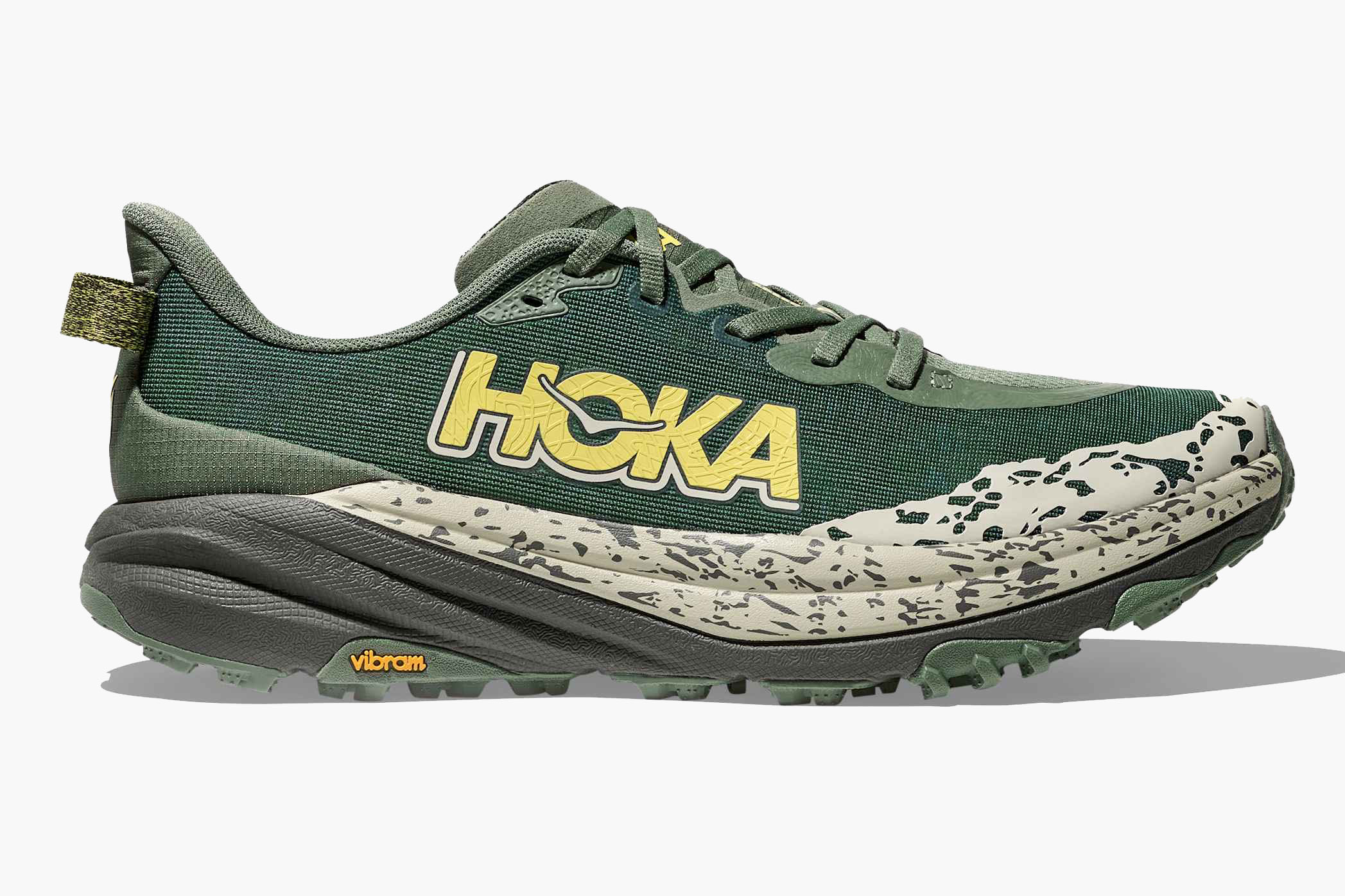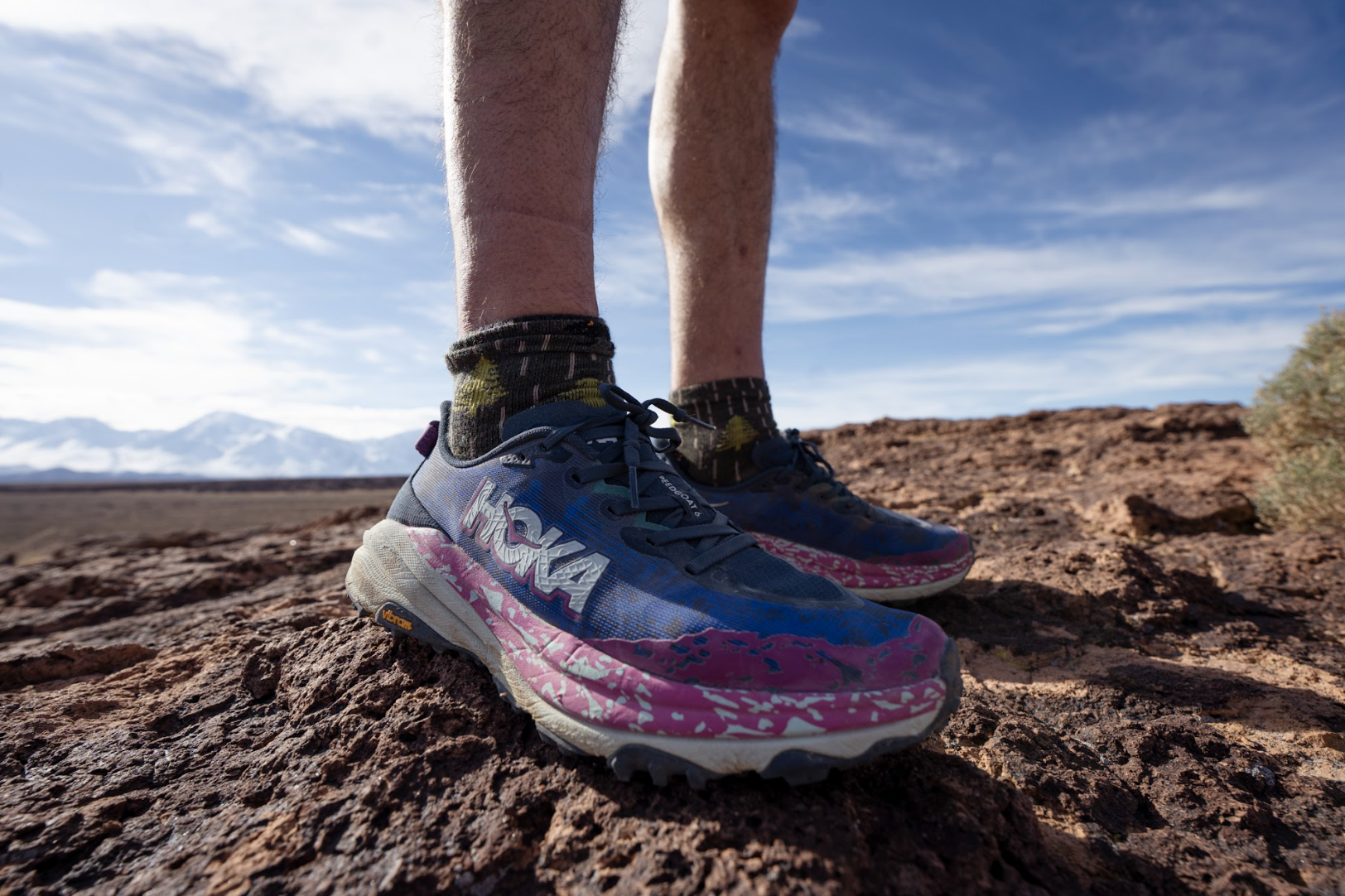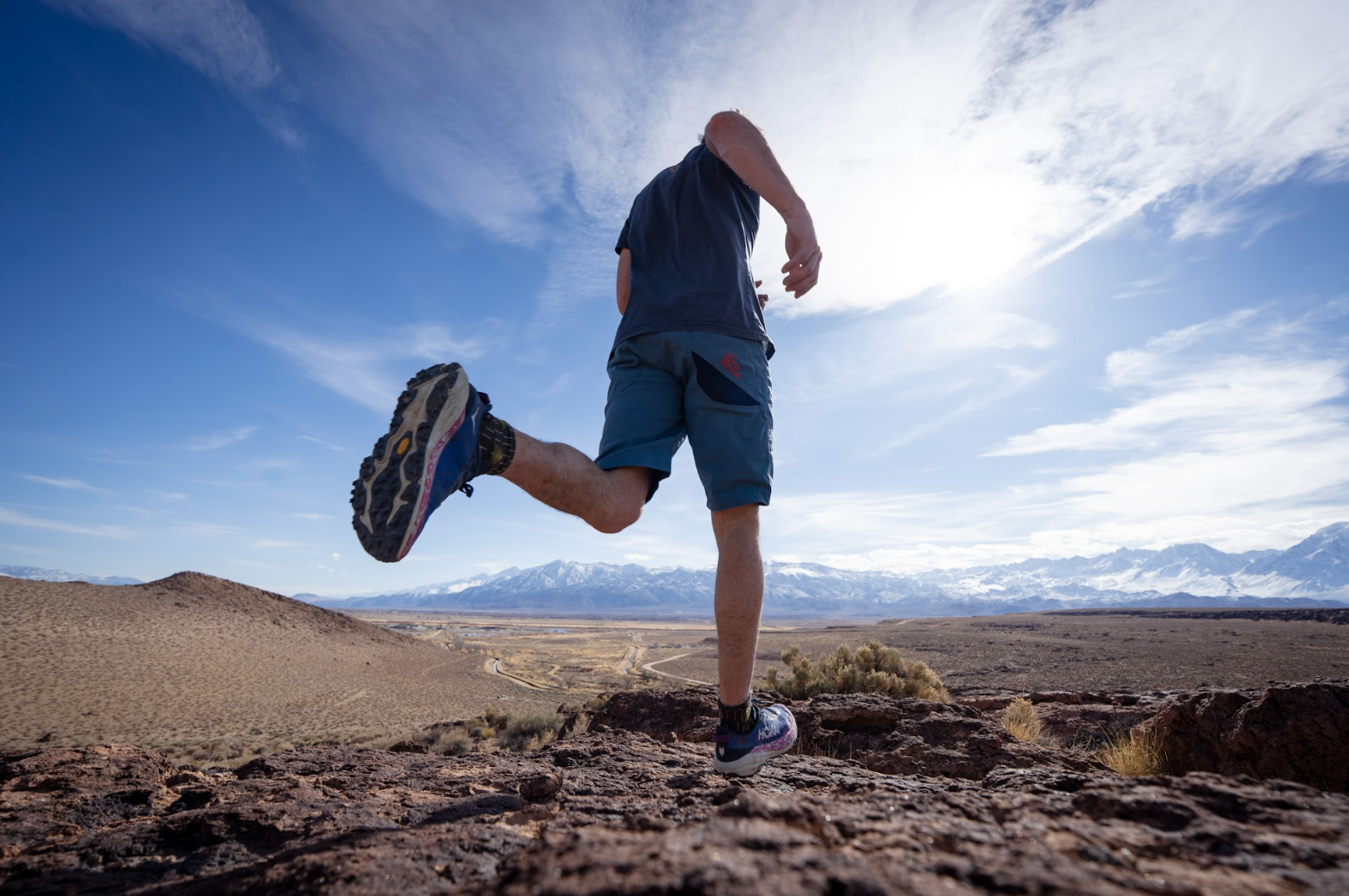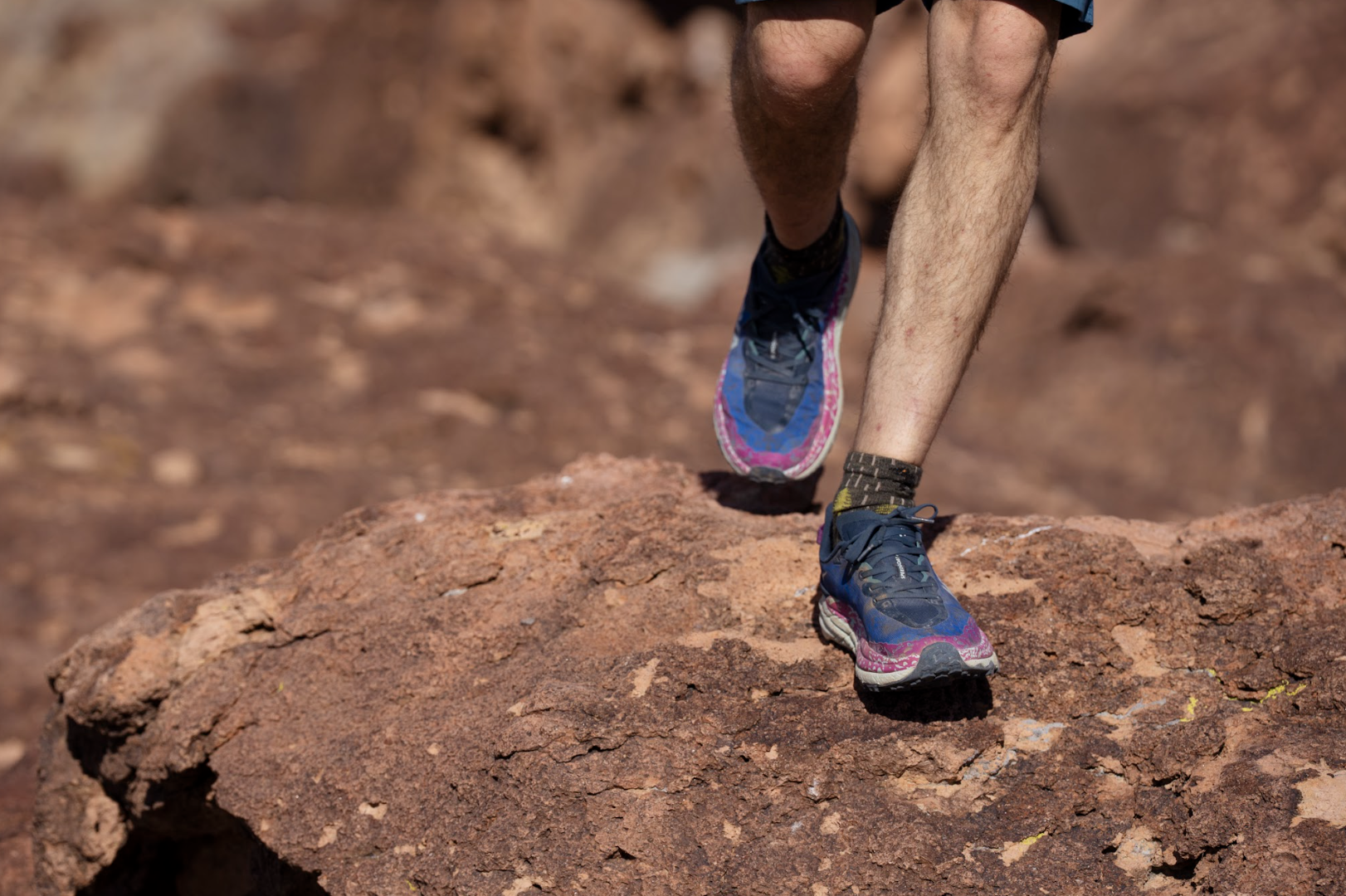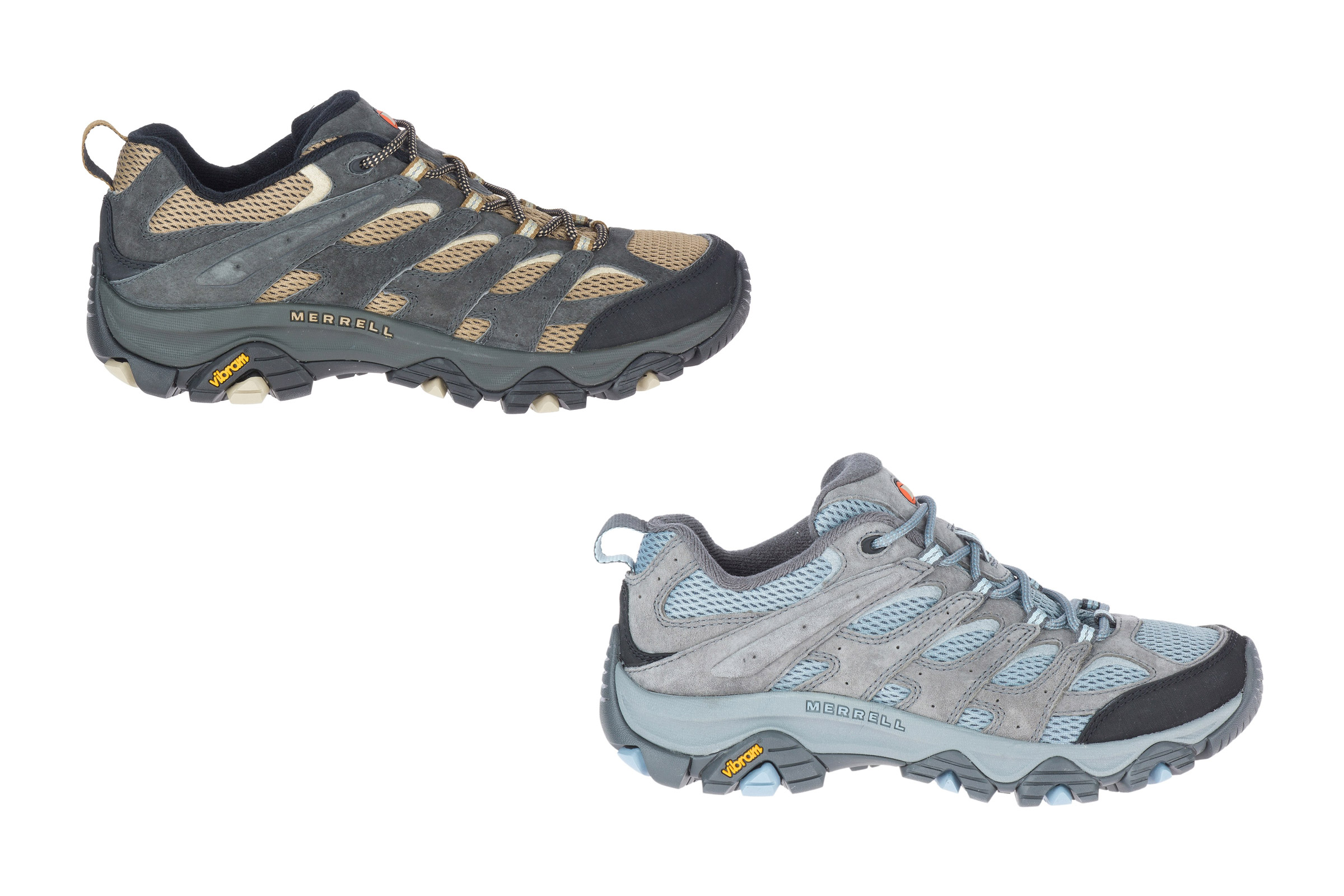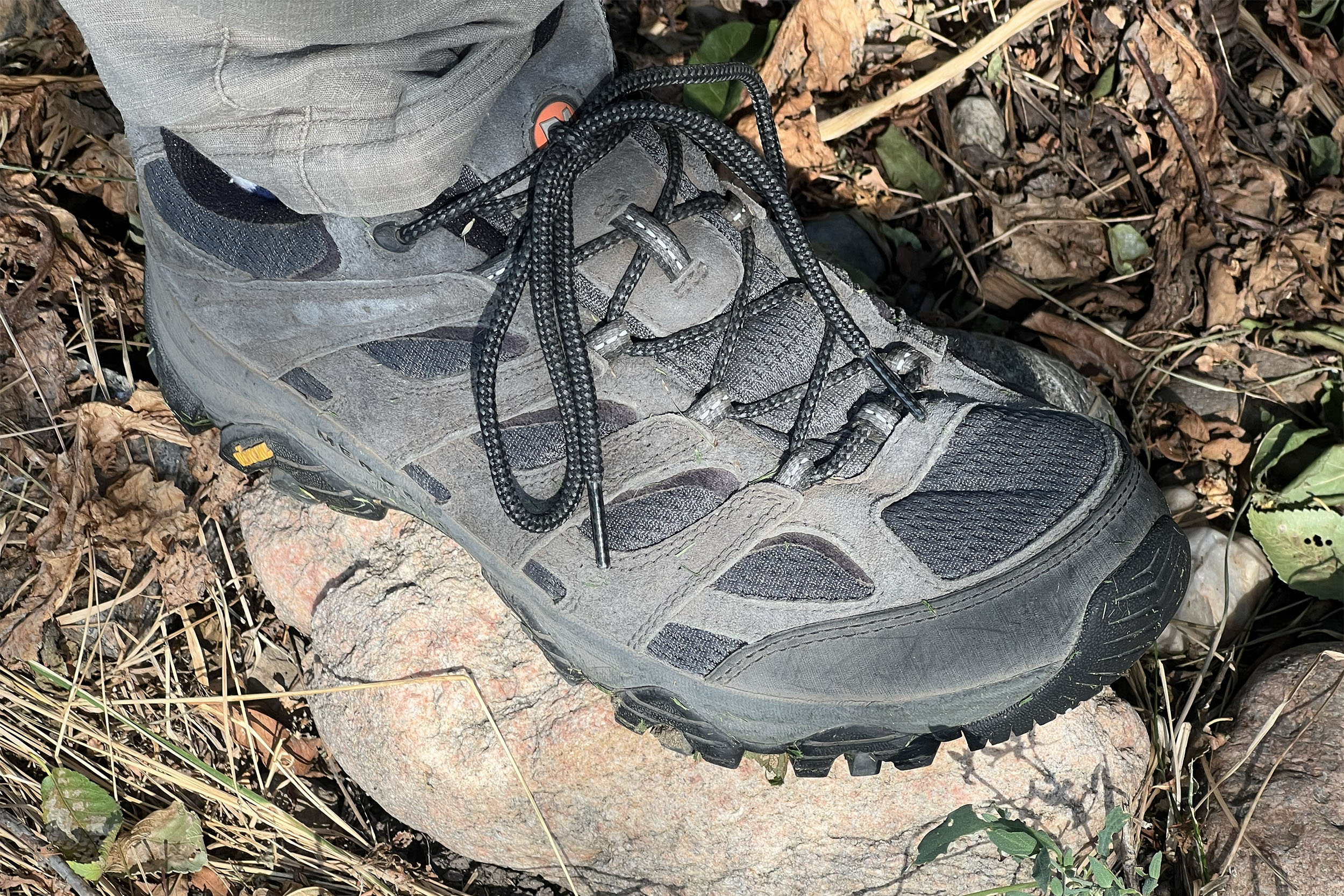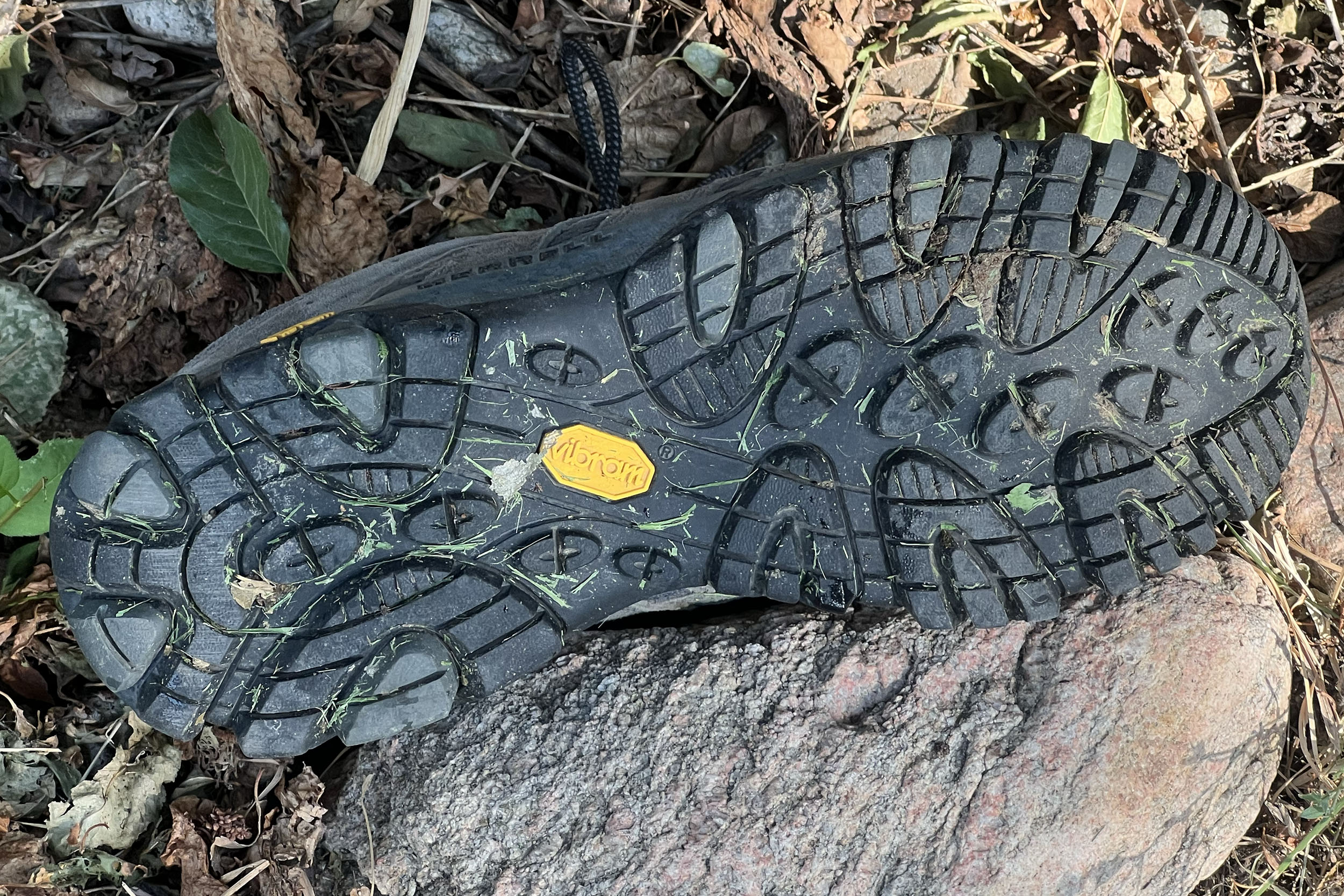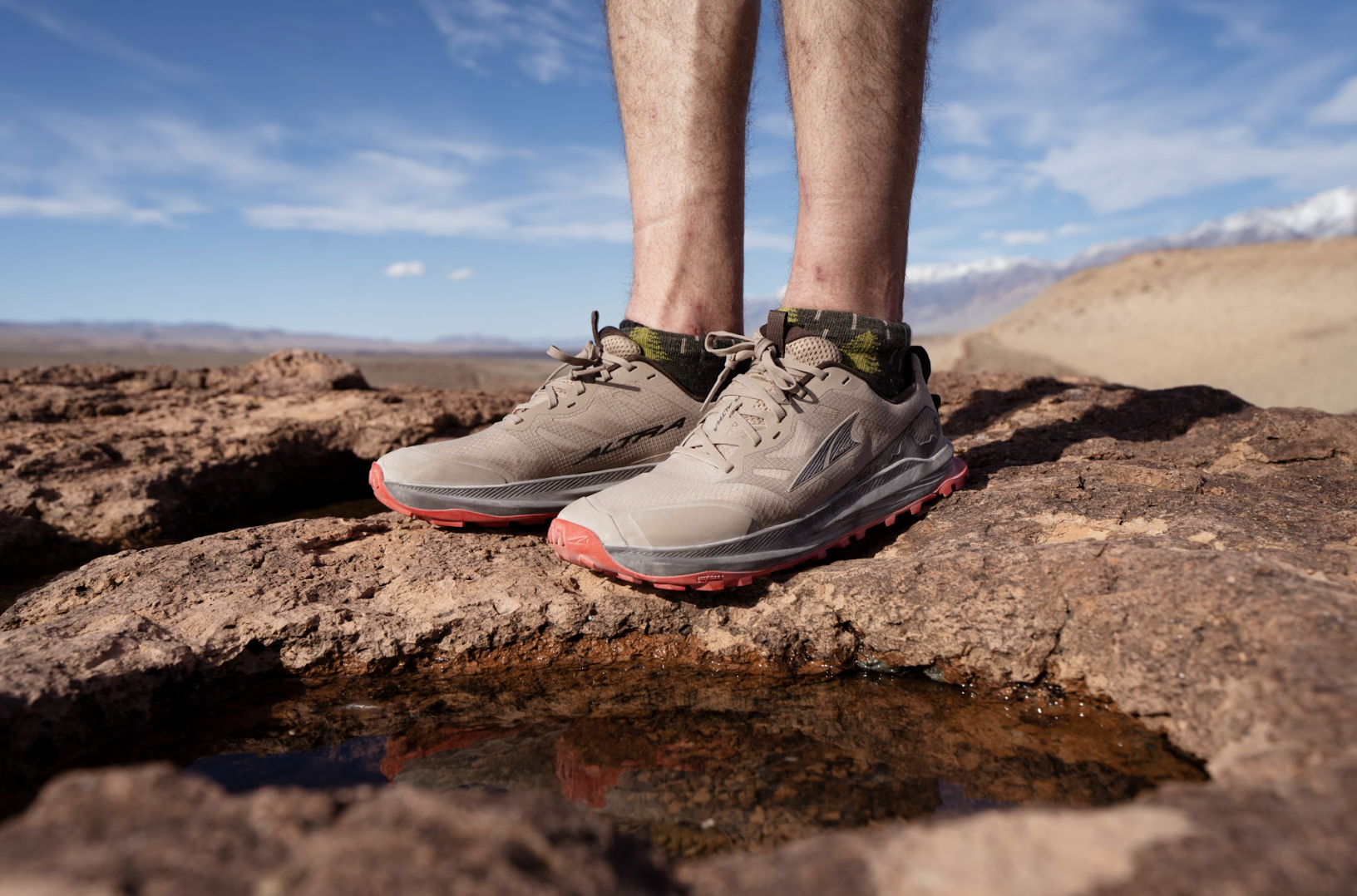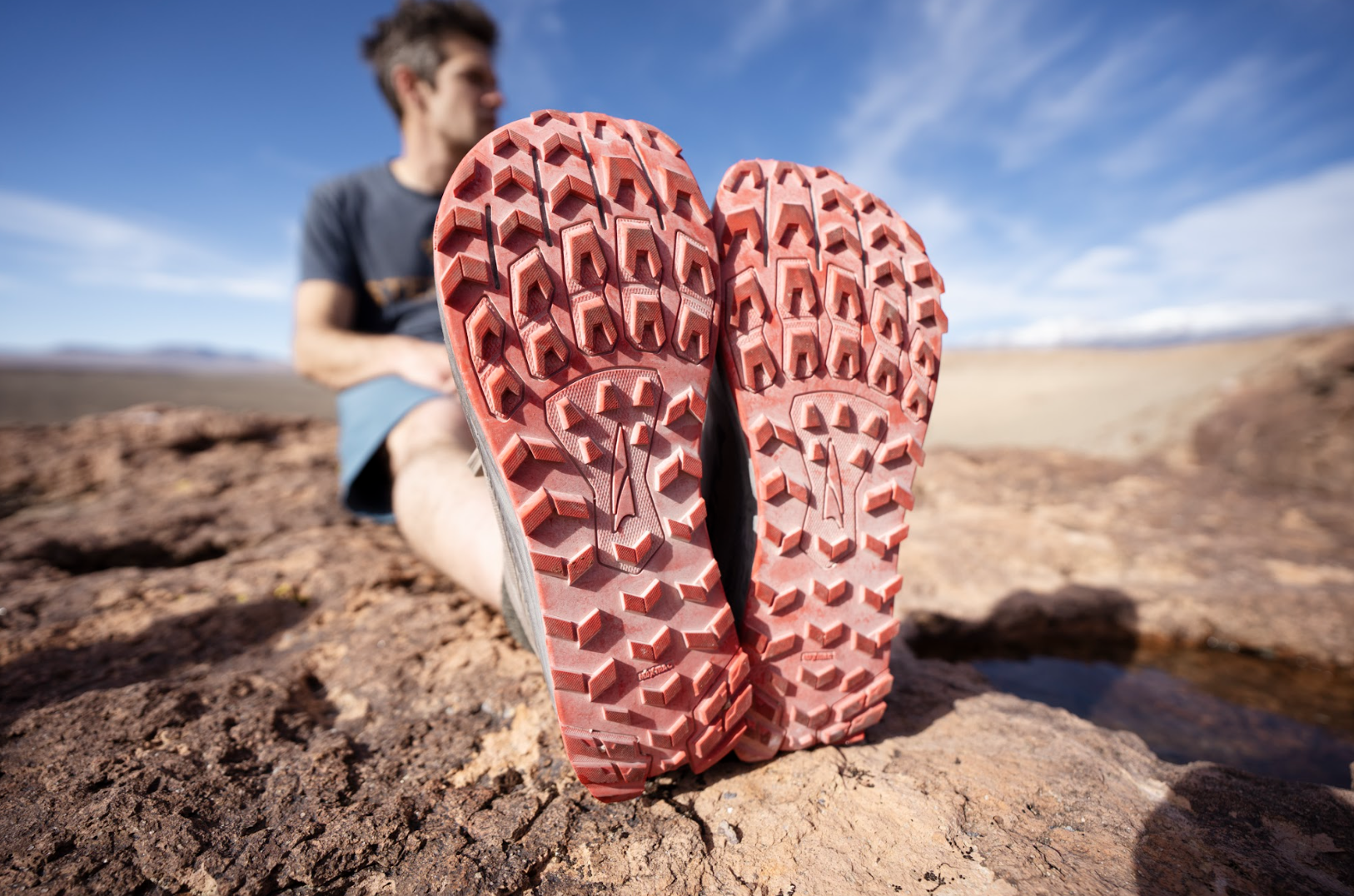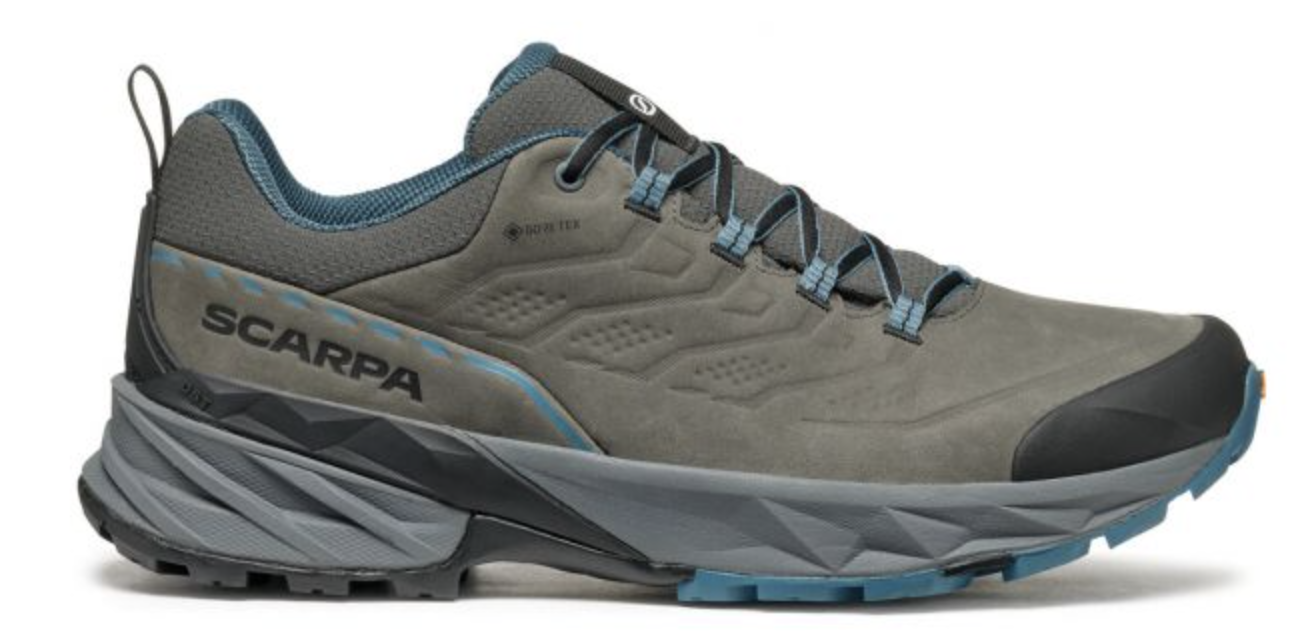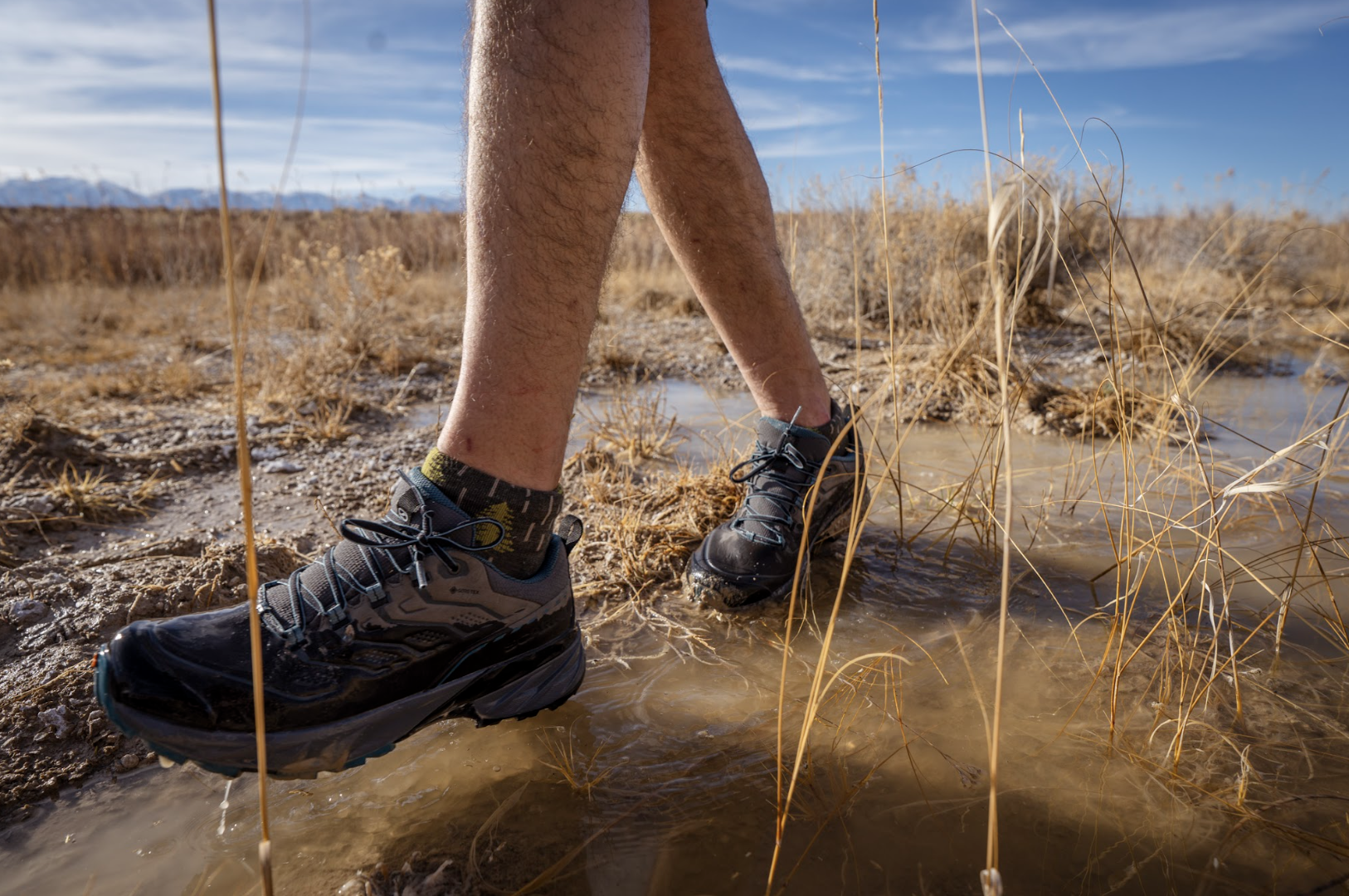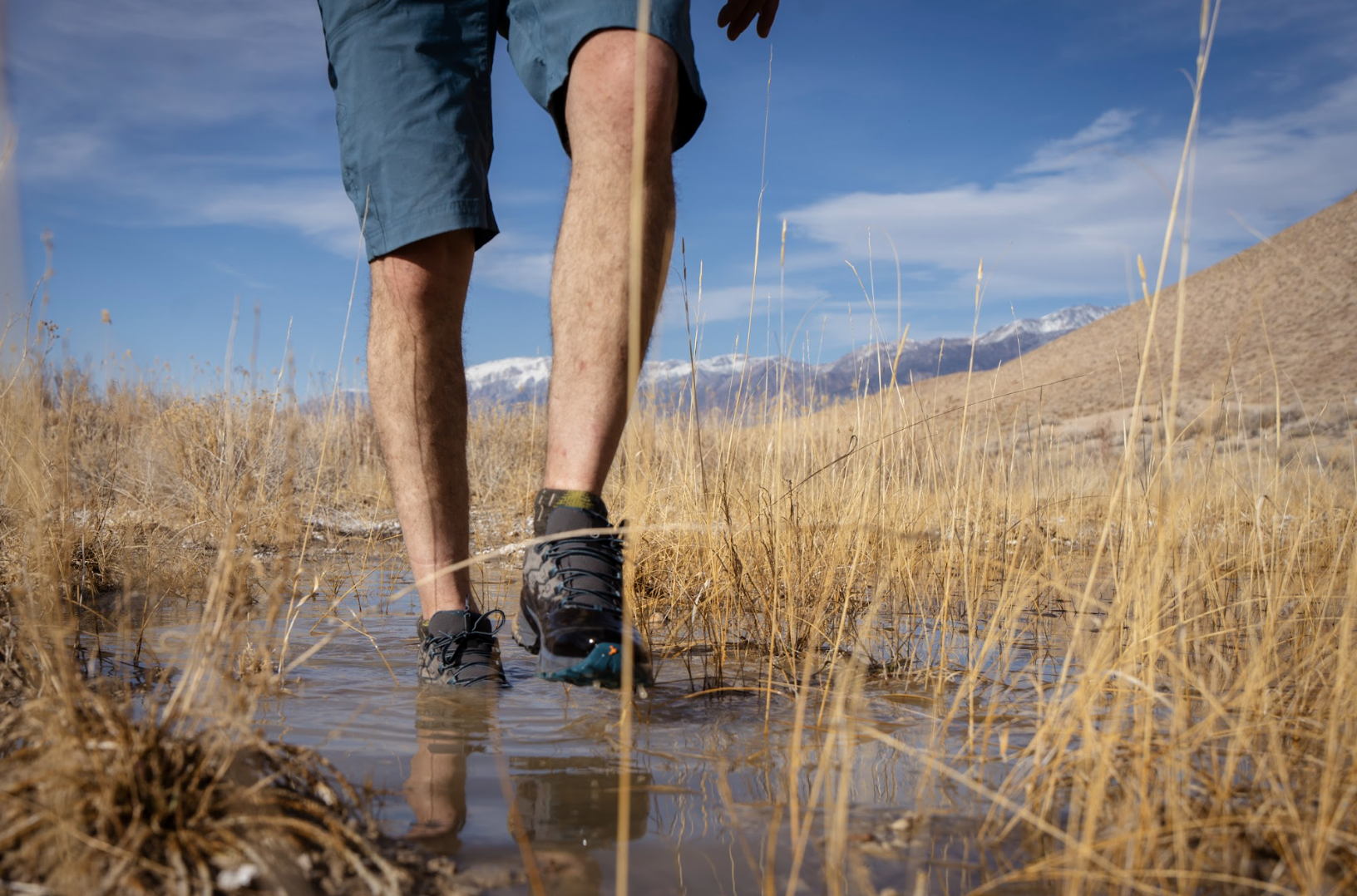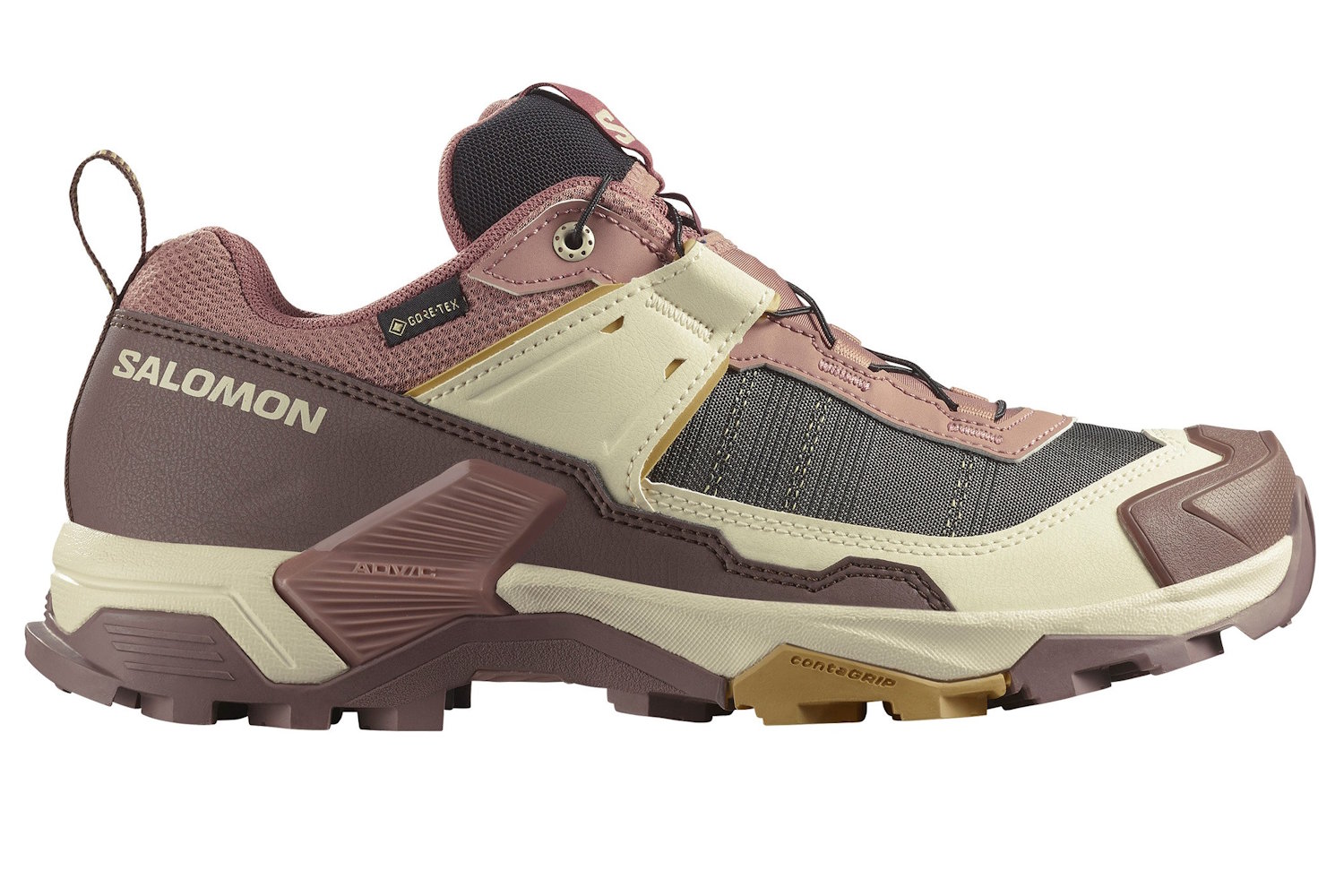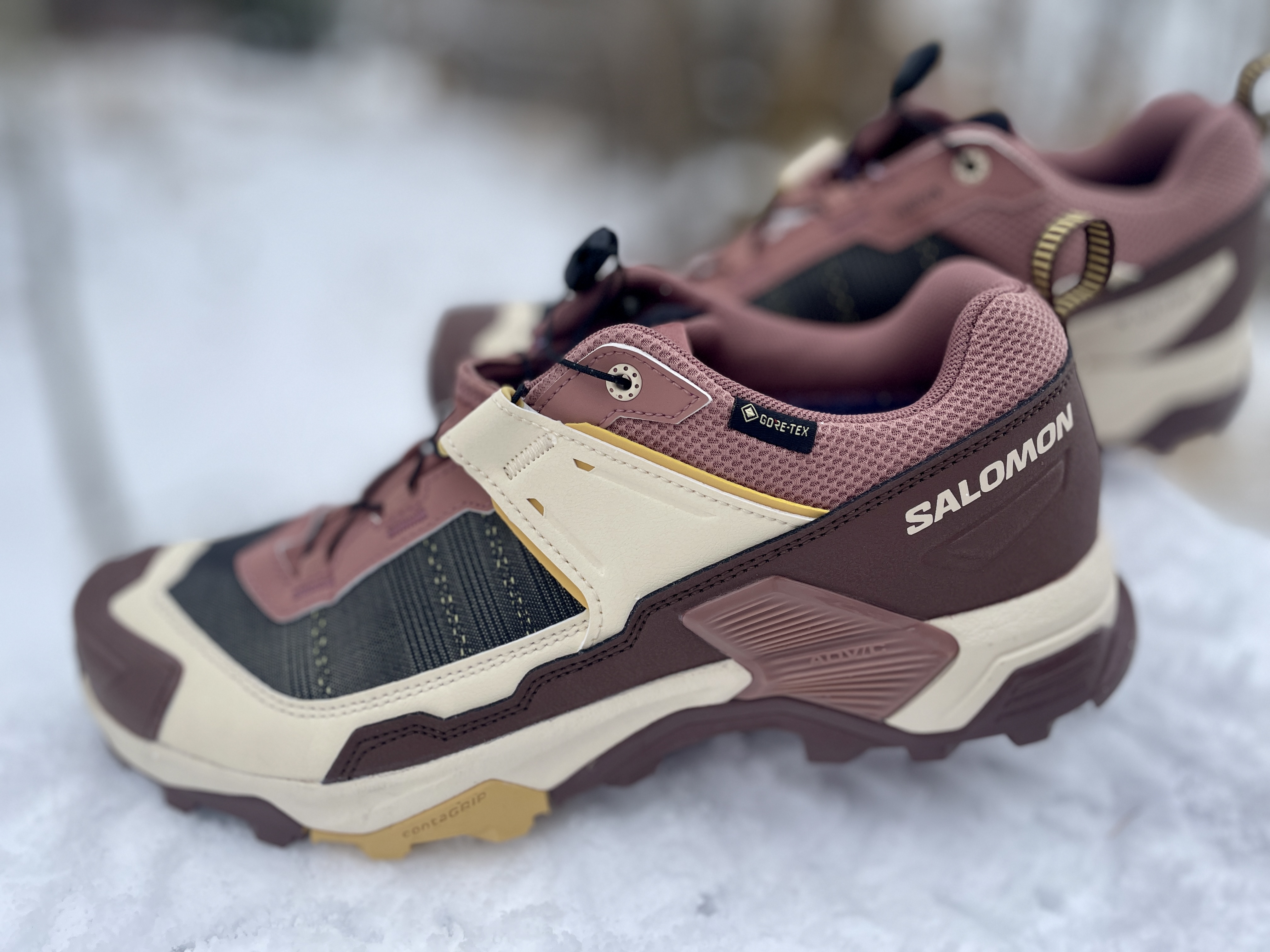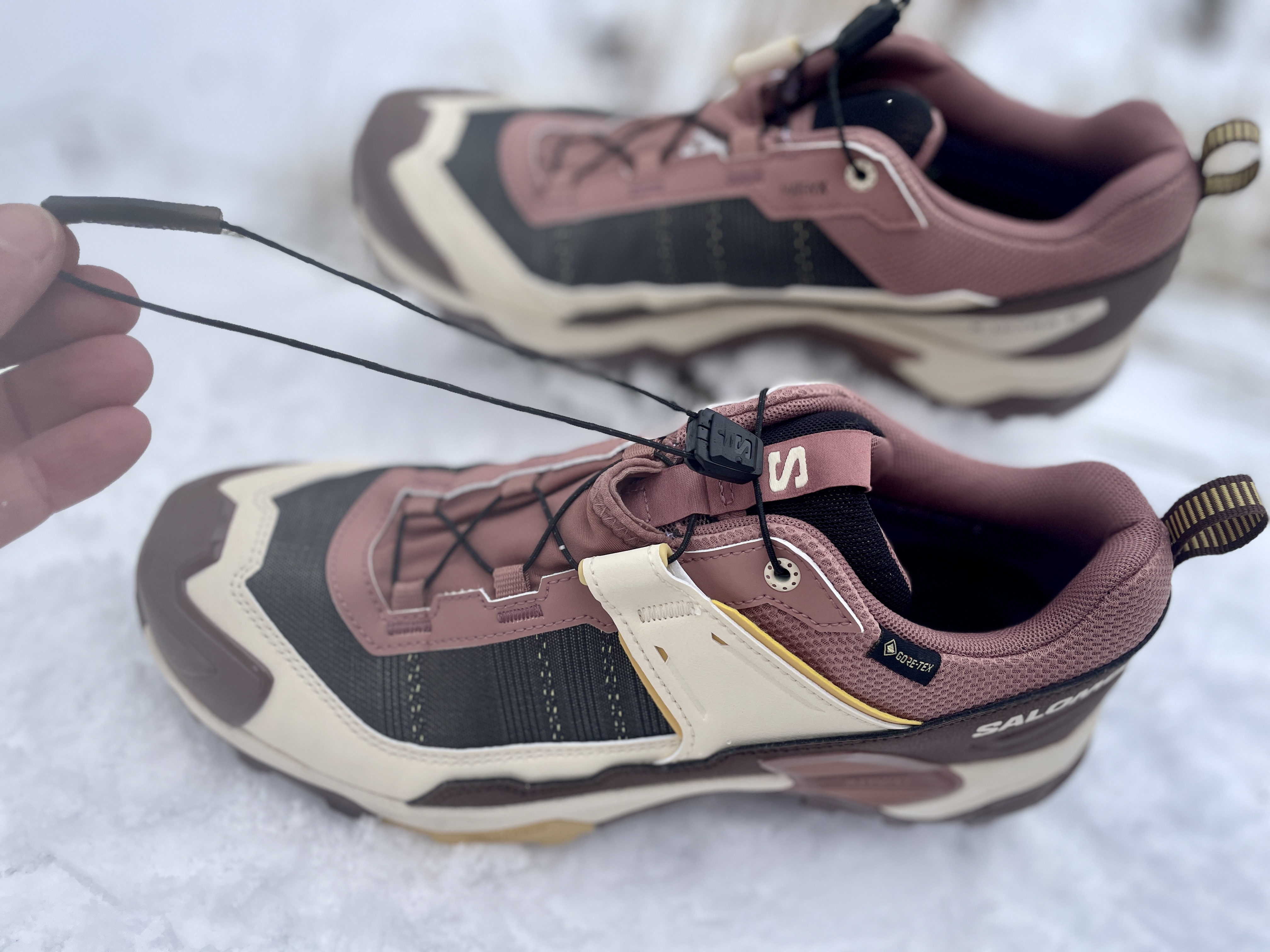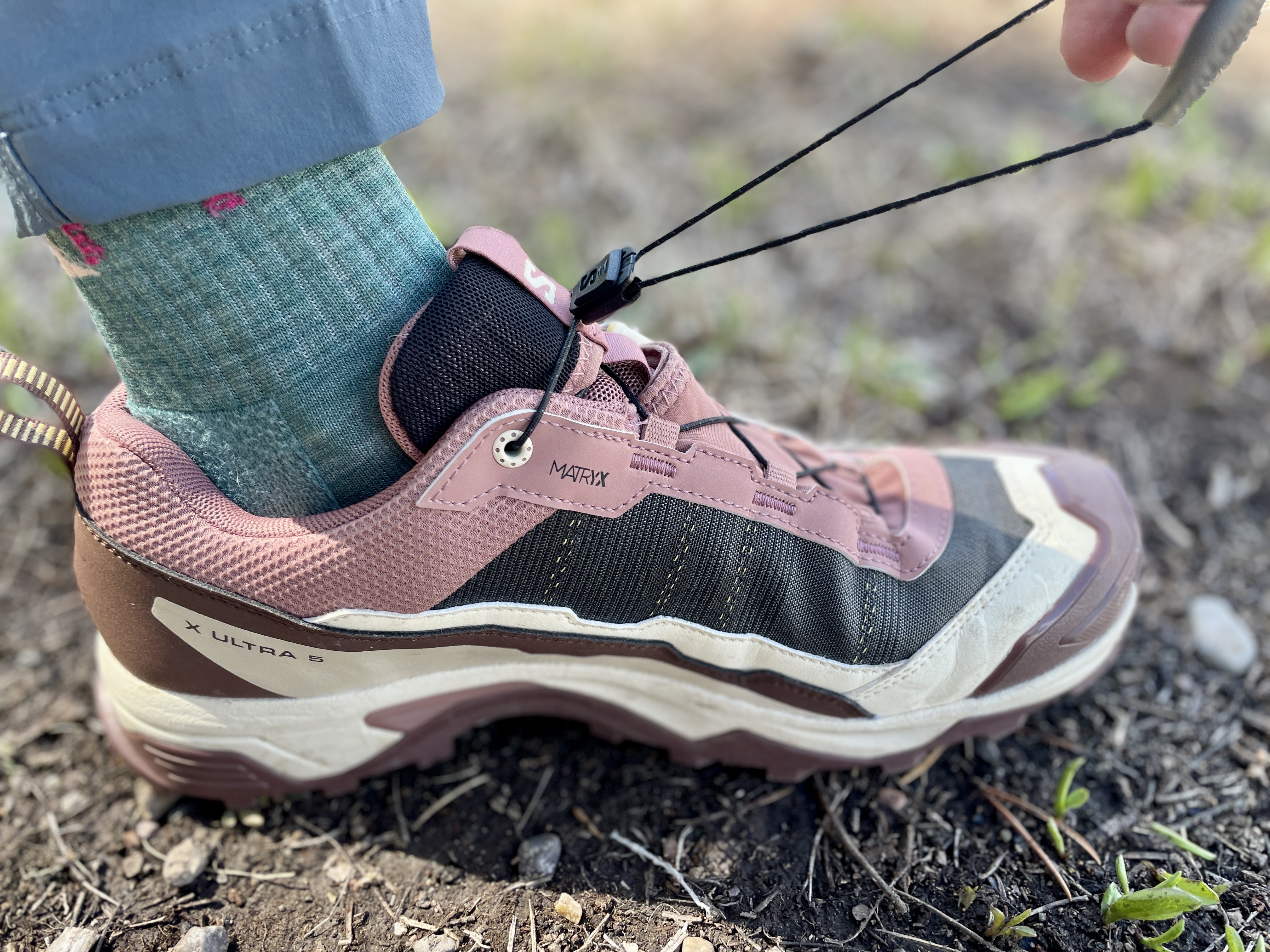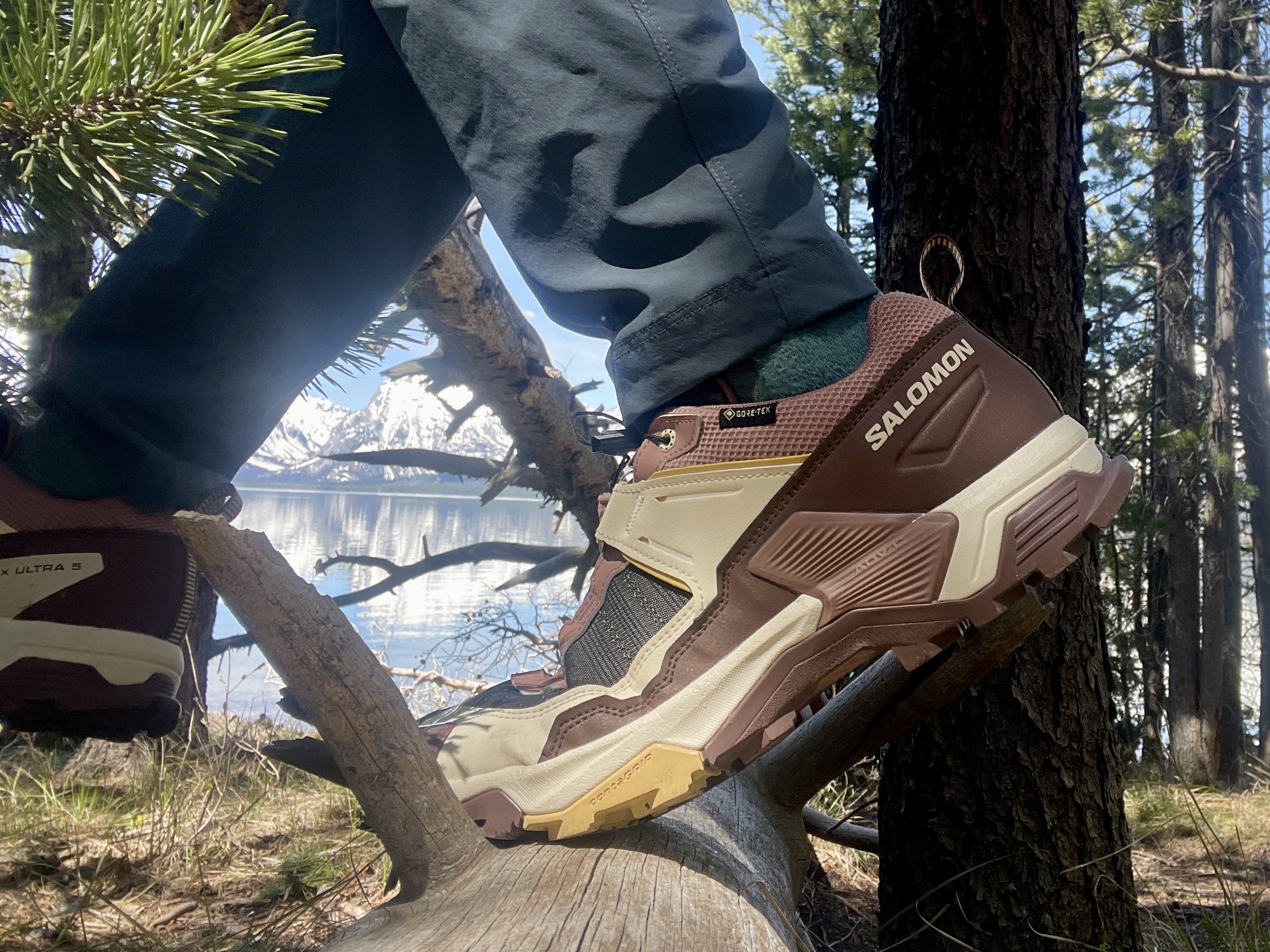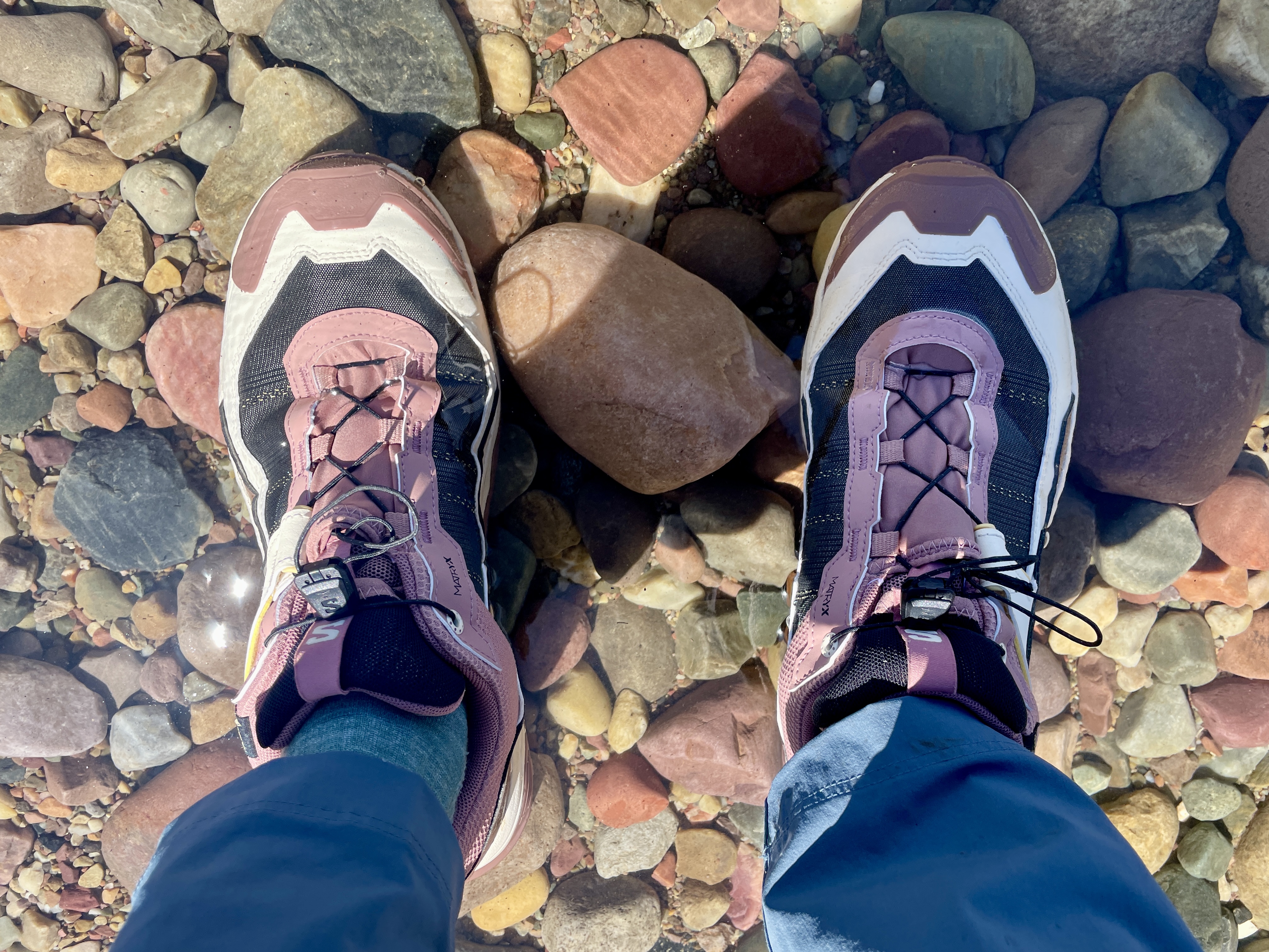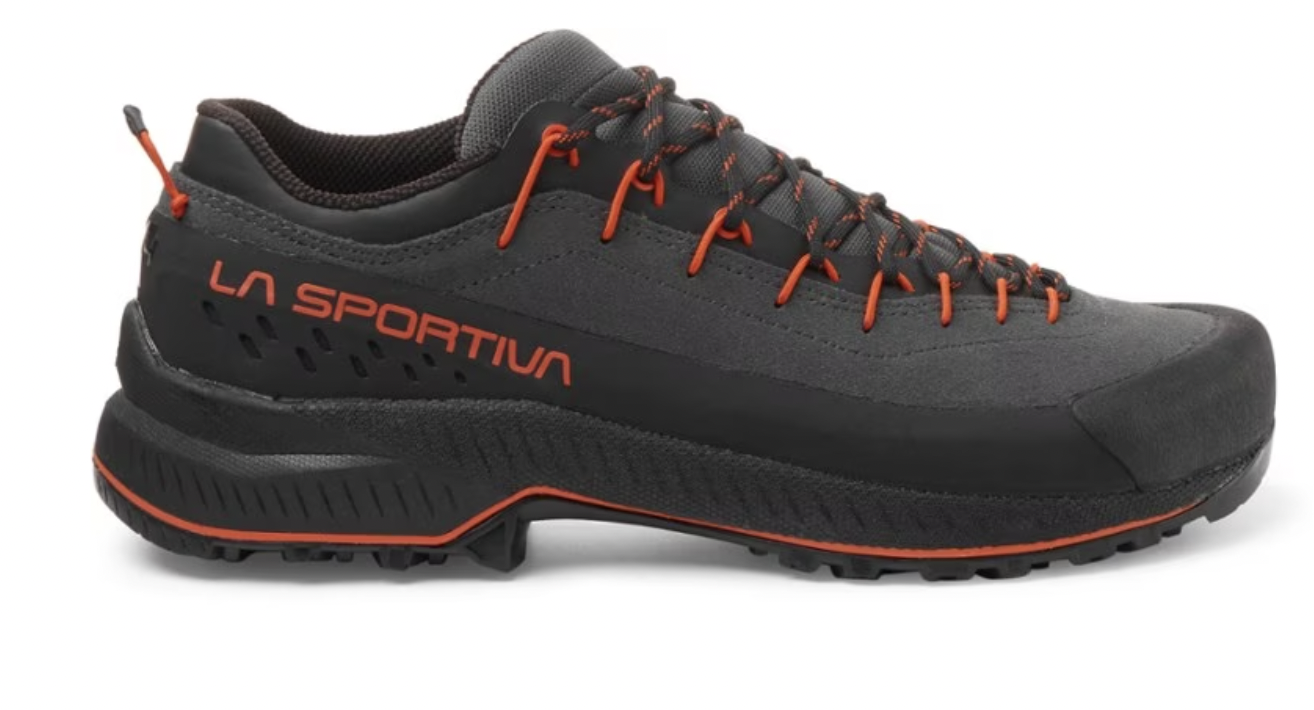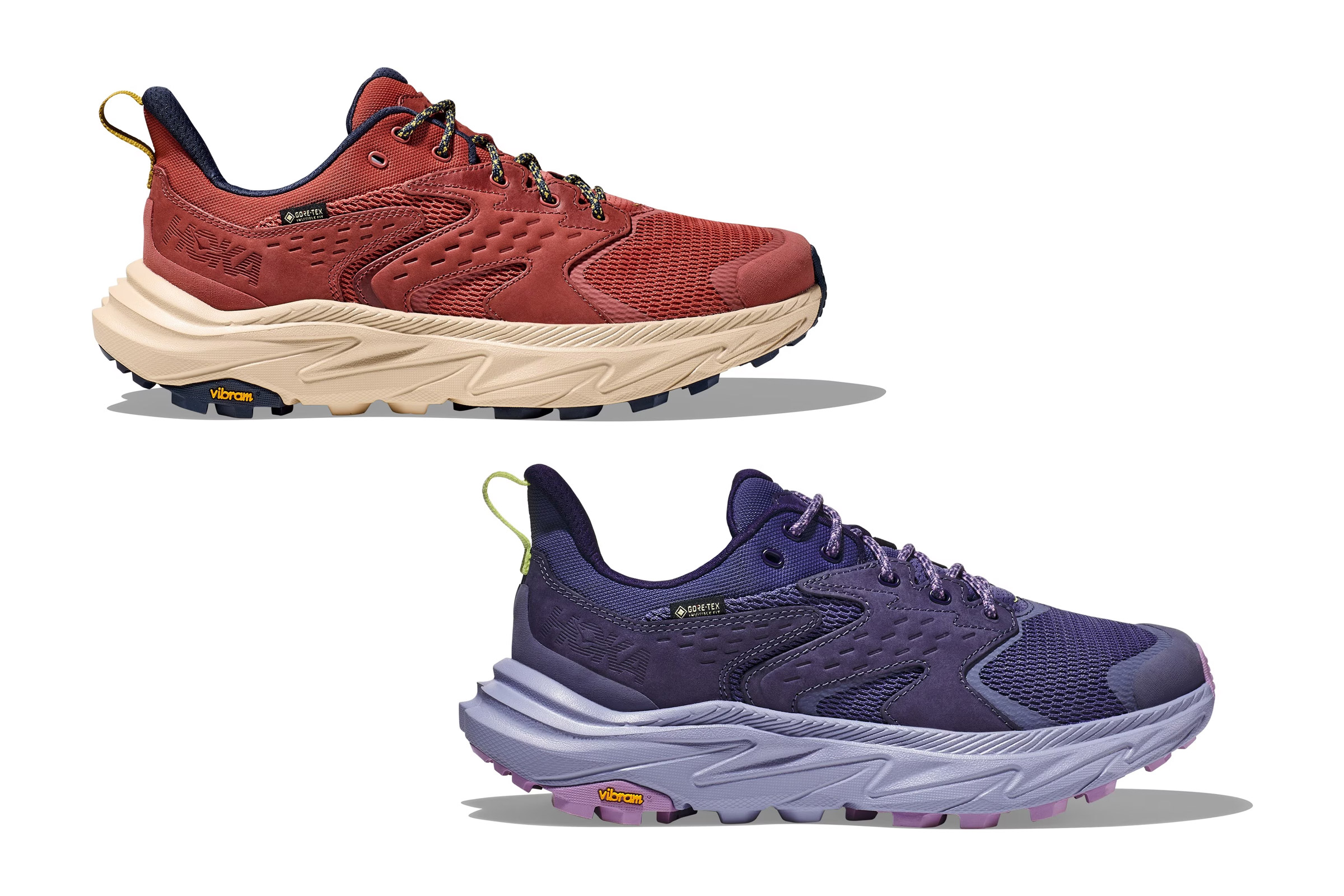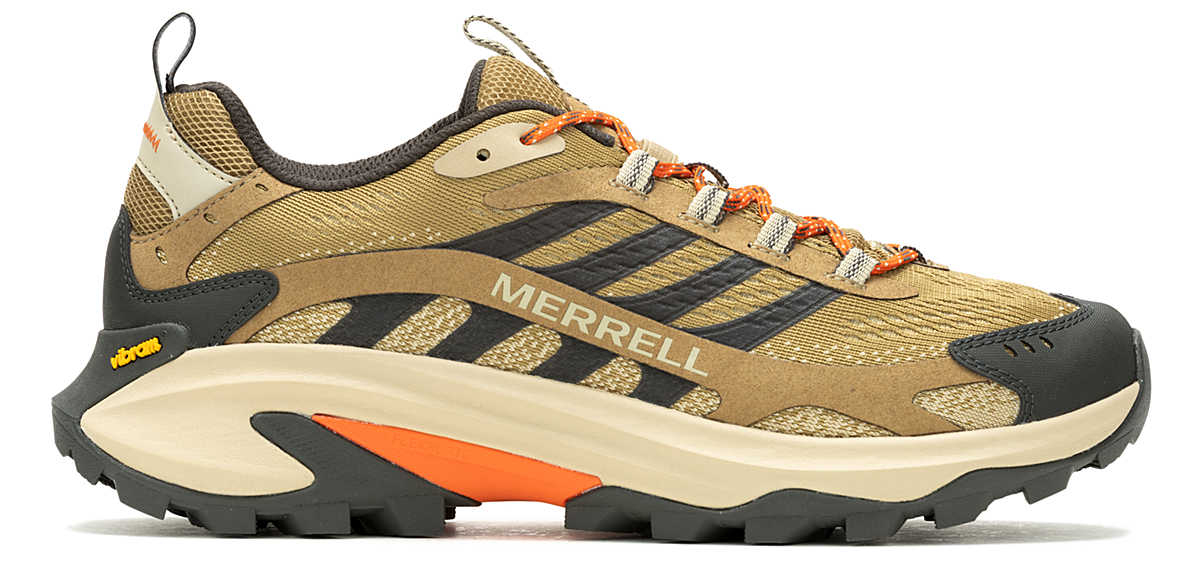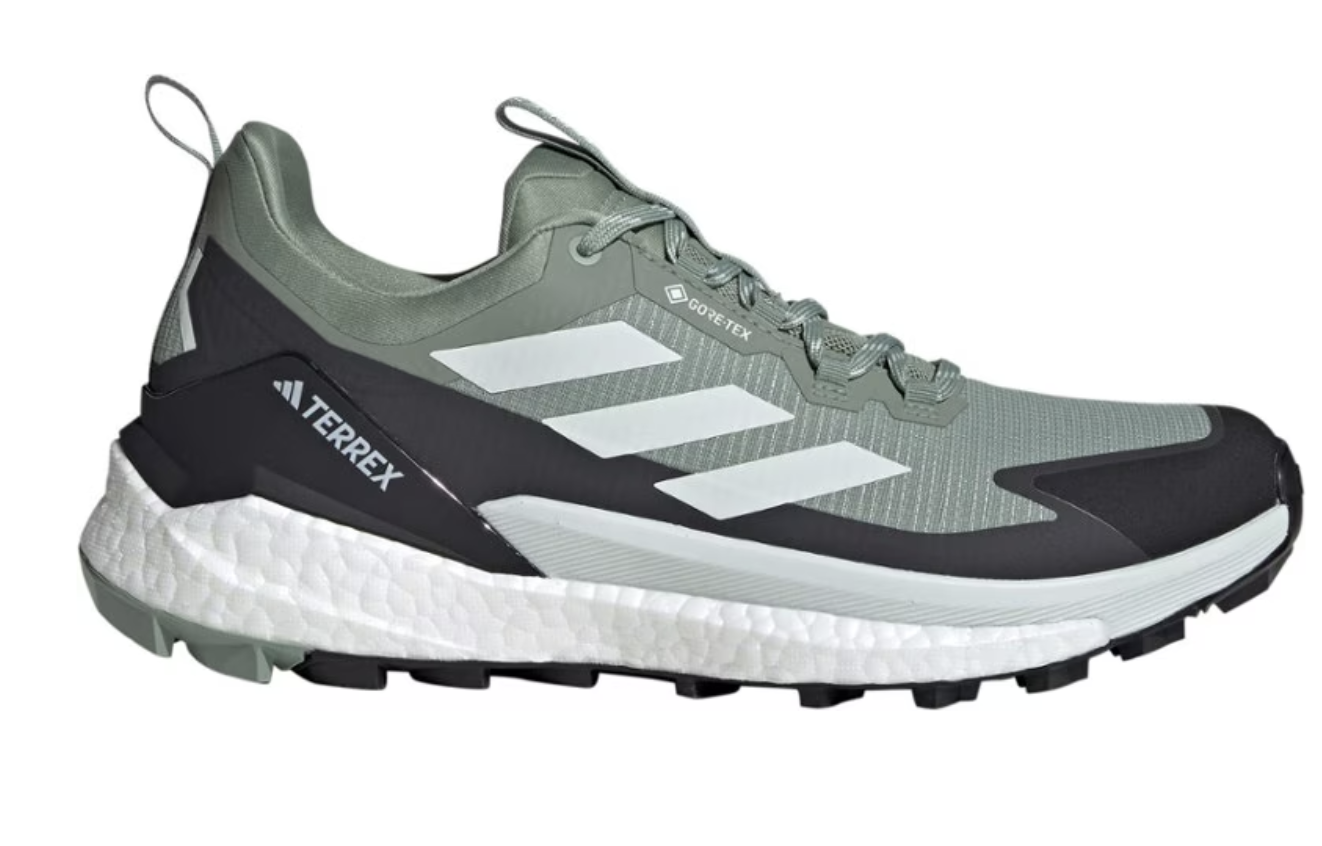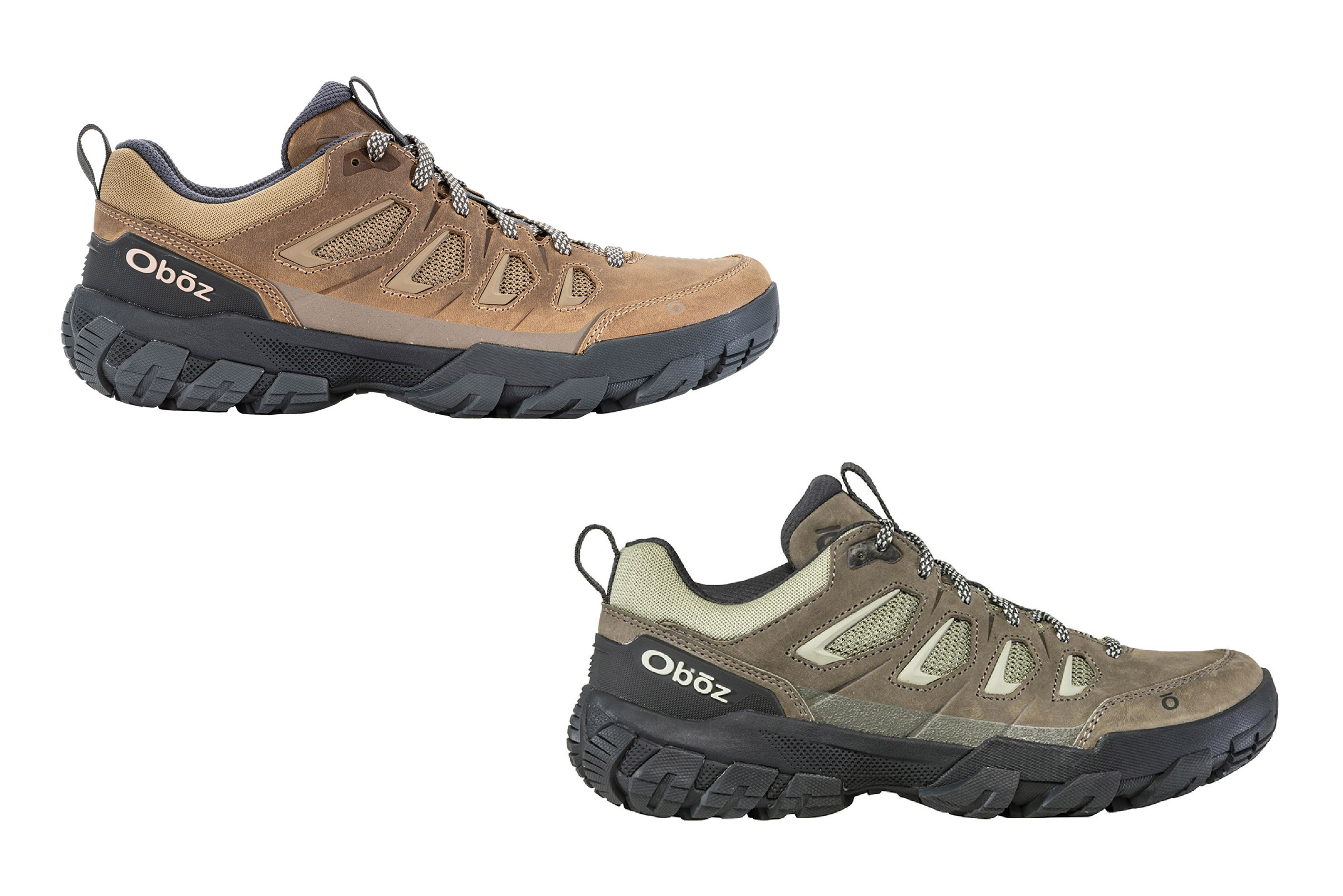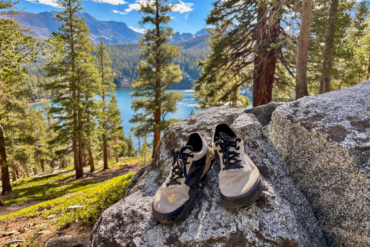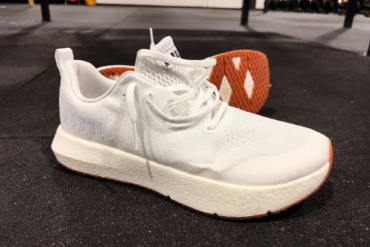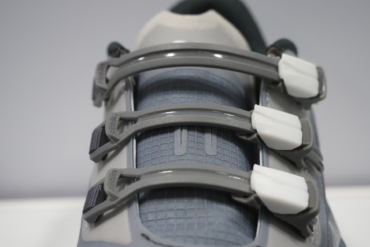We love a good pair of hiking boots, but the best hiking shoes are ideal for many trail adventures. They’re light, easy to move in, and keep your feet cool. You’ll give up a bit of ankle support with a shoe, but many find that the increased comfort and performance are well worth the trade-off.
This guide combines the perspectives of prolific thru-hiker Chris Carter, consummate woodsman Nick LeFort, and trail runner, hiker, and hunter Sean McCoy. Between them, they’ve spent thousands of miles testing hiking shoes from the eastern forest of Appalachia to granite peaks in California. After all that rambling, the Hoka Speedgoat 6 emerges as this season’s top pick, with the Merrell Moab 3 retaining its spot as the best budget shoe for more casual hikers.
Shoes are often a great choice when hiking on trails, even for big distances with packs. With lighter gear becoming mainstream, even beginners can easily get their kit under 30 pounds and negate the need for heavy, all-leather high-top boots. The list below highlights our favorite hiking shoes, field-tested and compared side-by-side. You’ll find many of our top choices are also excellent trail running shoes.
Editor’s Note: Updated August 15, 2025, with the addition of the Salomon X Ultra 5 GTX hiking boot.
The Best Hiking Shoes of 2025
Hoka Speedgoat 6
-
Stability
8.3
-
Durability
8.5
-
Style
8.8
-
Performance
9.5
- Weight: 1 lb. 3.6 oz.
- Heel-to-toe drop: 5 mm
- Waterproof: No
- Upper: Woven textile
- Outsole: Vibram Megagrip
Pros
- Stable for a trail runner
- Very responsive and fast
- "Locked-in" heel fit
- Fantastic trail running shoe
Cons
- Upper not as durable as leather
- Some may find these shoes narrow in the midfoot
Merrell Moab 3
-
Support
9.0
-
Durability
8.7
-
Style
7.0
-
Performance
7.6
- Weight: 2 lb., 1 oz.
- Upper: Pigskin leather and mesh
- Outsole: Vibram TC5+
Pros
- Good value
- Impressive traction and stability for a low-cut hiking shoe
- Breathable
Cons
- A bit heavy
- Requires a break-in period for peak comfort
Altra Lone Peak 9
-
Support
6.9
-
Durability
7.8
-
Style
8.4
-
Performance
9.0
- Weight: 1 lb. 6.4 oz.
- Heel-to-toe drop:
- Upper: Ripstop mesh
- Outsole: MaxTrac rubber
Pros
- Light weight
- Wide forefoot for swelling feet
- Zero drop promotes a healthy stride
- Quick gaitor attachment points
- Good, fast trail running shoe
Cons
- Zero drop takes some getting used to and isn't for everybody
- Modest support
Scarpa Rush 2 Pro GTX
-
Stability
8.3
-
Durability
9.0
-
Style
7.8
-
Performance
8.6
- Weight: 1 lb., 8 oz.
- Waterproof: Yes
- Upper: Nubuck leather
- Outsole: PRESA HIK-01
Pros
- Durable leather upper
- Running shoe feel, boot-like performance
- Waterproof
Cons
- Not very breathable
- Size up ½ size for better fit (More of PSA than a con)
Salomon X Ultra 5 GTX Hiking Shoe
-
Comfort
8.3
-
Support
8.2
-
Traction
8.8
-
Durability
8.7
- Weight: 1 lb., 6 oz.
- Drop: 11 mm
- Outsole: All-terrain Contagrip
- Upper: Matryx (made of individually coated polyamide and Kevlar yarns)
Pros
- Secure, snug, and virtually customized fit
- No break-in needed
- Durable yet lightweight and breathable
- Breathable
- Excellent traction and stability
Cons
- No backup if lacing system fails
La Sportiva TX4 EVO
-
Stability
9.1
-
Durability
9.2
-
Style
8.5
-
Performance
9.2
- Weight: 1 lb., 12 oz.
- Material: Nubuck leather
- Best use: Technical approaches or rocky scrambles
- Top attribute: Environmentally responsible construction and materials
Pros
- Extremely sticky rubber, great for rock
- Balance between comfort and support
- Durable and abrasion-resistant upper material
Cons
- Heavy
- Not great on mud
Other Rock-Solid Hiking Shoes We Tested
While the Hiking shoes below didn’t make the top of our list, they’re all well-designed and well-constructed. If you’re shopping for sales or just don’t like any of the shoes we’ve highlighted above, take a look at the best of the rest, and rest assured, they wouldn’t make the list if they weren’t quality options.
- Weight: 1 lb., 14.7 oz.
- Material: Recycled mesh
- Best use: Technical hiking over sludgy, slippery terrain
- Top attribute: Sustainable build with a tacky outsole
Pros
- Sustainably made
- Sticky Vibram Megagrip outsole with self-cleaning lug pattern
- Plenty of cushion
Cons
- Runs a bit large
- Extended heel cushion isn't everyone's cup of tea
- Pretty heavy
- Weight: 1 lb. 8 oz.
- Drop: 10mm
- Lug: 4mm Vibram traction
- Stack height: 34-24mm
- Midsole: FloatPro
- Outsole: Vibram TC5+
Pros
- Bellows tongue keeps shoes debris-free
- Comfortable and breathable
- Light on the feet
- Feels very stable with Lightweight Flexplate tech
Cons
- Pull tabs could be slightly larger
- Some complaints of sizing issues (try them on first!)
- Weight: 2 lbs., 1 oz.
- Material: Abrasion-resistant upper
- Best use: Trail running, Thru-hiking
- Top attributes: Abrasion-resistant upper, cushioning, Continental outsoles
Pros
- Lots of cushion
- Springy heels
- Advanced stability
Cons
- They look like Grampa’s lawn mowing shoes
- Weight: 1 lb., 8 oz.
- Material: Leather
- Best use: Day hikes, dry summer adventures, town-to-trail excursions
- Top attribute: Out-of-the-box comfort, breathable, stylish
Pros
- Stylish
- Breathable
- Grippy outsole
Cons
- Expensive compared to other options
- Weight: 1 lb., 15.6 oz.
- Material: Oiled nubuck leather and CORDURA fabric mesh
- Best use: Mid-to-high-mileage backpacking journeys with loads up to 50 lbs.
- Top attribute: Versatility
Pros
- Grippy outsole
- Minimal break-in period
- Durable
Cons
- Heavier than others
- Take forever to dry out if they get wet
Hiking Shoe Comparison Table
| Hiking Shoe | Price | Waterproof | Weight (per pair) | Upper | Outsole |
|---|---|---|---|---|---|
| Hoka Speedgoat 6 | $155 | No | 1 lb., 3.6 oz. | Woven textile | Vibram Megagrip |
| Merrell Moab 3 | $140 | No | 2 lb., 1 oz. | Pigskin leather/mesh upper | Vibram TC5+ |
| Altra Lone Peak 9 | $140 | No | 1 lb., 6.4 oz. | Ripstop mesh | MaxTrac rubber |
| Scarpa Rush 2 Pro GTX | $189 | Yes | 1 lb., 8 oz. | Nubuck Leather | PRESA |
| Salomon X Ultra 5 GTX | $170 | No | 1 lb., 9.6 oz. | synthetic textile | Contagrip MA |
| La Sportiva TX4 EVO | $189 | No | 1 lb., 12 oz. | Nubuck leather | Vibram Megagrip |
| HOKA Anacapa 2 Low GTX | $180 | Yes | 1 lb., 14.6 oz. | 100% recycled nubuck leather | Vibram Megagrip |
| Merrell Moab Speed 2 | $140 | No | 1 lb., 8 oz. | Engineered Mesh/TPU | Vibram TC5+ |
| Adidas Terrex Free Hiker GORE-TEX 2.0 Low | $180 | Yes | 2 lb., 1 oz. | Synthetic | Continental rubber |
| Danner Trail 2650 | $170 | No | 1 lb., 8 oz. | Suede leather | Vibram Megagrip |
| Oboz Sawtooth X Low | $140 | No | 1 lb., 15.6 oz. | True Tread rubber | Nubuck leather/CORDURA fabric |
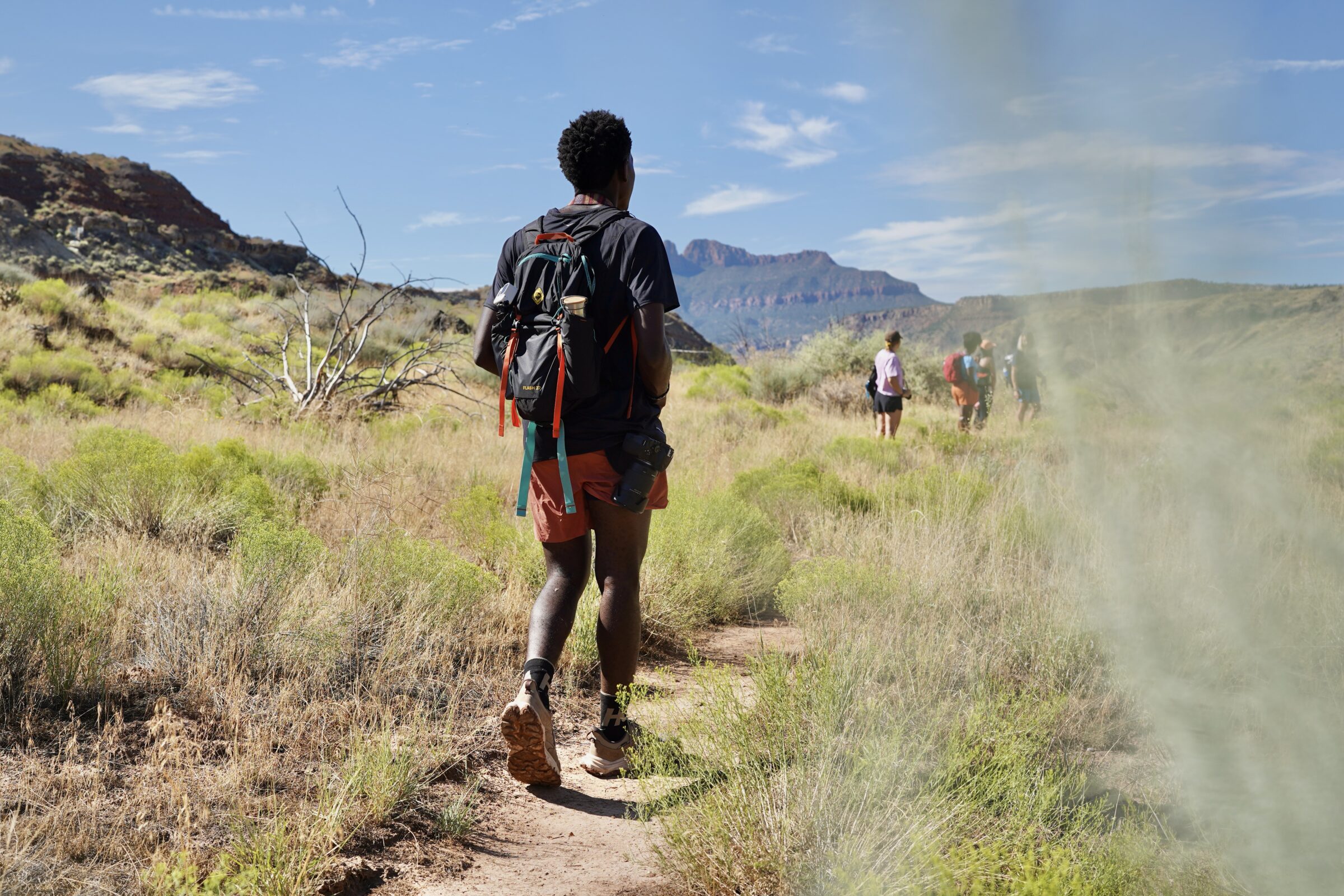
How We Tested Hiking Shoes
In our search for the best hiking shoes, we spent months on the trail. From the dry Arizona desert to the hot and humid Appalachian Trail and the Rocky Mountains — we’ve logged a lot of miles.
The recommendations on this list are the result of intensive testing and thorough observation. “Hiking” is a broad term, and not all hikers have the same needs. While compiling our roundup, we considered each individual model’s intended use. We paid careful attention to comfort, stability, outsole traction and grip, and long-term durability.
Our Expert Testers
Senior Editor Chris Carter took the wheel on this guide in August 2022 and has been rummaging around his shoe rack and combing the internet ever since to bring you the most current, deserving selection possible. Chris has thru-hiked the Triple Crown of long trails in the United States: the Pacific Crest Trail, the Continental Divide Trail, and the Appalachian Trail. He’s plodded back and forth across the country in countless different models of shoes and knows the importance of dialing in on the perfect fit for various adventures and terrain.
More recently, hiker and GearJunkie contributor Nick LeFort has been taking the latest and greatest hiking shoes for a spin. Nick is a former boot fitter who knows his way around a Brannock device and can make solid recommendations for any foot shape.
Additionally, GearJunkie editors Will Brendza and Matt Bento have added their 2 cents and then some to this guide, testing and reviewing the most recent updates to popular models like the Hoka Speedgoat and the Altra Lone Peak 9. As a journalist covering outdoor gear and news, Will has tested shoes and boots from every major brand.
Matt spent his college years fitting boots and shoes at a small outfitter in Greensboro, N.C., and then moved to Yosemite, where he worked as a Ranger and on the Yosemite Search and Rescue team. Now as an editor at GearJunkie, he tests and totally trashes all manner of footwear while he explores his big backyard in Bishop, Calif.
Our Testing Grounds
We test hiking shoes on and off trail, mostly in the western U.S. Will Brendza lives in the Denver area, where he has quick access to local canyons and trails, and the Rocky Mountain National Park is just a short drive away. Matt Bento can be in on the trail and trudging in the John Muir Wilderness and on to Sequoia National Park after a 15-minute drive from his doorstep.
Both mountain areas offer a wide range of trail conditions throughout the year, thanks to dramatic elevation gains. On the same day, our testers find themselves scrambling up smooth rock slabs, crossing snow fields, and bombing down loose gravel and scree, all excellent scenarios for evaluating hiking shoes.
The American West is pretty dry, and our testers generally shy away from waterproof shoes with GORE-TEX in favor of more breathable, non-waterproof models. To even out their bias, tester Nick LeFort is out in Middletown, Conn., where an average of 48 inches of rain often makes a waterproof hiking shoe a necessity.
Bench Testing
We strive to have as many shoes in hand as possible for comparative testing. Pulling out insoles to measure them with calipers and compare their shapes, walking laps up the same hill with a different shoe on each foot, and standing in a bucket full of water are all in a day’s work for our shoe testers. These tests give us quick, objective data points that help us decide which shoes are the best.
We use our detailed write-ups to expand upon the subjective — how the shoes feel underfoot, how they respond to different terrain, and whether or not we get blisters or hotspots. Fit is the most important aspect to consider when shopping for a pair of hiking shoes, and also the hardest thing to discern from reading reviews on the internet, so we expound on how a shoe fits as much as we can.
If you need to carry super-heavy loads or are just looking for some more ankle support, be sure to check out our guide to the best hiking boots. For a women’s-specific perspective, have a look at the best women’s hiking shoes.
Buyer’s Guide: How to Choose the Best Hiking Shoes

From day hiking to thru-hiking, the right pair of hiking shoes can become the most beloved and essential piece of gear in your kit. As the primary contact between you and the trail, your shoes make your adventures possible, and it’s imperative that they’re reliable.
While some still prefer the ankle support and robust structure of hiking boots, more and more hikers and backpackers are opting for the weight savings and nimble performance of hiking shoes. For any hiking endeavor, good-quality shoes are more than capable of handling a wide variety of terrain.
Because there are so many styles and variables, selecting the best hiking shoes for your unique needs can be difficult. In this guide, we include everything you need to know to select a pair of shoes that will treat your feet well and instill confidence in your stride.
Hiking Shoes vs. Boots

One of the main differences between hiking shoes and boots is the height. Whereas shoes have a below-the-ankle height, hiking boots offer full ankle support and high-top construction. What you give up in ankle support, you make up for in weight savings and out-of-the-box comfort.
Hiking shoes are great for day hikes, smooth trails, and anytime you want to go fast and light. For bigger backpacking trips with a heavier backpacking pack, you may want to consider a full hiking boot. That said, we know thru-hikers who swear by lightweight hiking shoes and day-trippers who won’t head out without their boots. It’s all about preference.
And while there isn’t a single best hiking shoe for everyone out there, we’ve broken down this list into categories to help find the best hiking shoe for you.
Weight

In recent years, hiking shoe technology has moved toward low-profile and lightweight designs. Modern fabrics and soles manage to be thinner and lighter without sacrificing performance on the trail. For long hikes and thru-hikes, the benefits of a light pair of shoes only grow as the miles wear on.
While many burly hiking boots weigh over 4 pounds per pair, hiking shoes tend to weigh around 2 pounds or less. If you like to go fast on the trail, or if you plan to do some trail running in your hiking shoes, light is undoubtedly better.
Yes, shaving ounces sometimes does reduce long-term durability. However, lots of pairs of shoes on this list are more than capable of holding up just as long as a hefty pair of boots.
With modern materials and advancements in design, you don’t need to give up durability to cut weight and gain comfort. The shoes on this list range from speedy lightweight models, like Hoka’s Speedgoat 5s at 1 pound, 4.6 ounces, to beefy but stalwart shoes like the Oboz Sawtooth X Low, tipping the scales at 1 pound, 15.6 ounces.

Comfort and Fit
Comfort is the most important factor for any pair of active footwear. The shape of the human foot varies wildly, and the shoe that feels comfortable to someone else might not be comfortable for you. Feet can be wide or narrow, arches can be high or flat, and heels can be bulbous or low volume.
When selecting a pair of hiking shoes, there is really no substitute for trying them on and paying attention to how they feel in action. Most people will want to seek out a fit that minimizes negative space but does not actively constrict or compress their feet or toes.
If your foot moves in the shoe, you’ll likely be dealing with blisters before long. In general, hiking shoes tend to be more comfortable than hiking boots. It’s totally possible to find a pair that you can happily wear all day long.
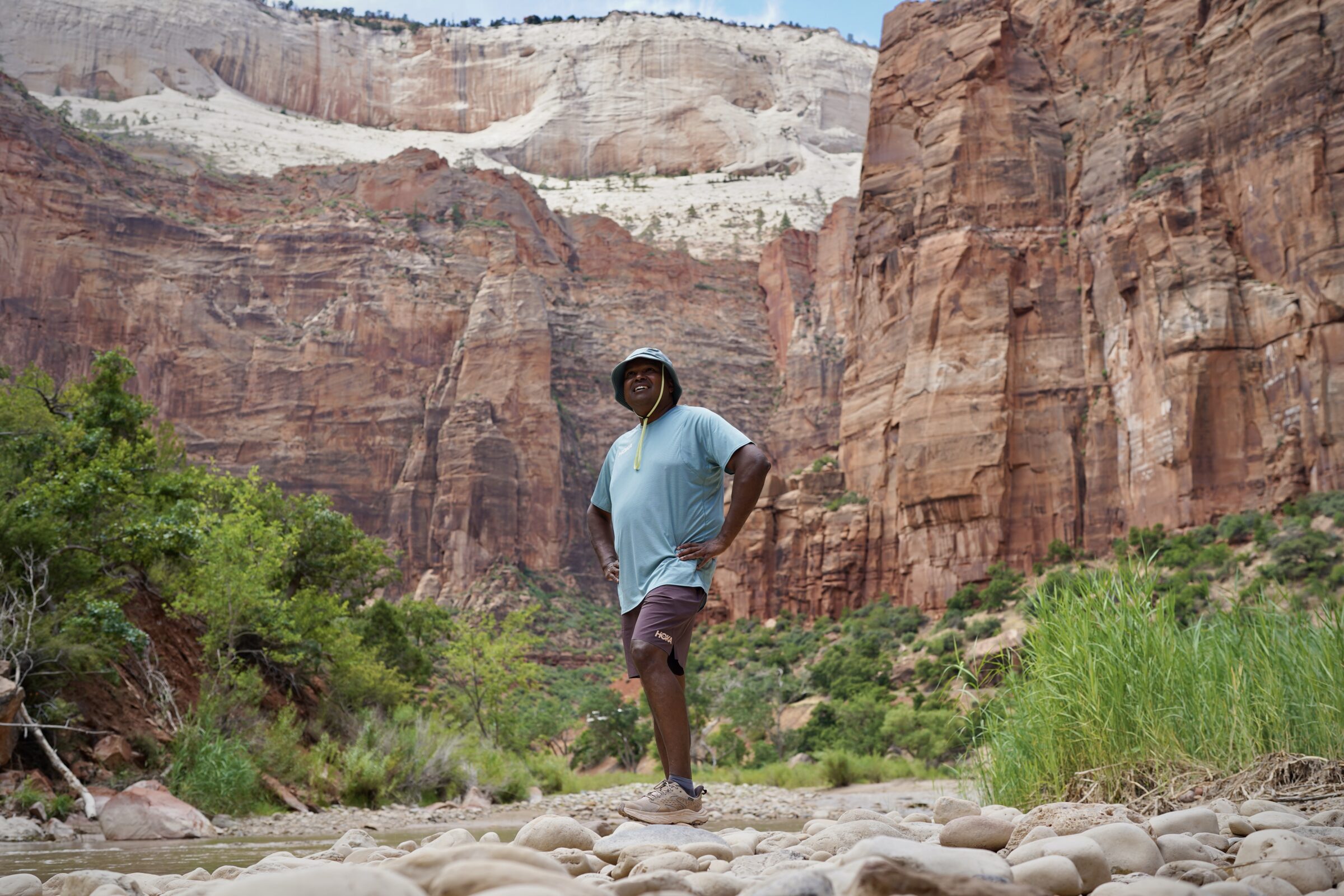
Waterproof
There are pros and cons to hiking in a pair of shoes that are billed as “waterproof.” When hiking on muddy and wet terrain, waterproof hiking shoes help keep your feet dry and comfortable. When your feet are wet, you’ll be more likely to develop blisters and other foot issues.
However, waterproof hiking shoes also tend to be warmer and less breathable. Once wet, waterproof shoes usually take longer to fully dry.
Most waterproof hiking shoes include a membrane in their liner (GORE-TEX is the most common) that keeps water from reaching the inside of the shoe. In addition, many hiking shoes are treated with a durable water-repellent coating, which can be reapplied after it wears off.
While it is good to prioritize dry feet, it is also important to remember that by sealing moisture out, you’re also sealing it in. Shoes with a waterproof liner are prone to becoming hot and sweaty in warm or humid conditions. All hiking shoes will soak through if they get very wet or become fully submerged, even if they’re labeled as waterproof.
Durability and Materials

The two primary areas of a hiking shoe that will suffer the most from wear are the upper and the outsole. On top of the shoe, the upper is the material that determines how waterproof, durable, and breathable the shoe is overall.
Most hiking shoes include an upper made from nylon, mesh, leather, or a combination. Nylon is lightweight and breathable, but it may not hold up well to repeated abrasion.
Mesh tends to be the least hardy, but it is super breathable and makes a comfortable choice for the tongue of a shoe. Leather is significantly less breathable, and it is often found on heavier-duty hiking shoes because it holds up to wear.
Although heavier and burlier hiking shoes often have the advantage of durability, many modern lightweight options are impressively long-lasting, too. Softer rubber outsoles will wear through faster than dense, firm outsoles.
Hiking Shoes Lifespan
It’s important that you don’t wear your hiking shoes (or boots) for longer than you should. Just because your toes aren’t hanging out of holes on the side, doesn’t mean the shoe has more life in it. Each manufacturer recommends different mileage for each shoe, but as a general rule, you want to replace your hiking shoes after 300-800 miles.
Many trail running shoes-turned-hiking shoes (such as Altra’s Lone Peak and Brooks’ Cascadia) are not designed to handle the same level of abuse as dedicated hiking shoes. It’s a good idea to retire shoes like these after between 300 and 500 miles.
Stalwart hiking shoes like Merrell’s Moab are crafted for endless days on the trail. Wearing a heavy pack will last you between 500 and 800 miles before you should lay them to rest.
It’s important to keep a rough estimate of the number of miles on your hiking shoes to avoid injury on trail. We like to keep a running document on our computer with a list of what trips we’ve done on each shoe, and how many miles were added each time. This may not be necessary for you personally, but we clock a heck of a lot of miles each year and have several different shoes in rotation.

Stability and Support
A shoe’s support comes from the construction of its components, including the sole and the midsole. These underfoot layers can be thick and sturdy, or thin and floppy.
For hiking, most people prefer a shoe that is stiff and stable through the middle part of the foot, but slightly more flexible near the toe. This allows your foot to feel supported without sacrificing the ability to flex your toes.
Most hiking shoes have a low-cut ankle collar. If you need more ankle support, hiking boots are probably a better choice.
Lacing Systems

The way a shoe laces up can make or break your big-mile adventure. Not being able to find a comfortably snug fit or fighting with constant loosening are both frustrating trail experiences.
Some shoes have a single-pull system. And while it looks delicate and breakable, we’ve had no issues with long-term durability. Many testers find this system allows for a dialed fit, and we appreciate the ability to make quick adjustments.
That said, it’s harder to create a more custom tightness with quick laces. They tend to provide the same tension across the entire foot. If you prefer to create pockets of snugness across your foot, go with a traditional lacing system.
Traction
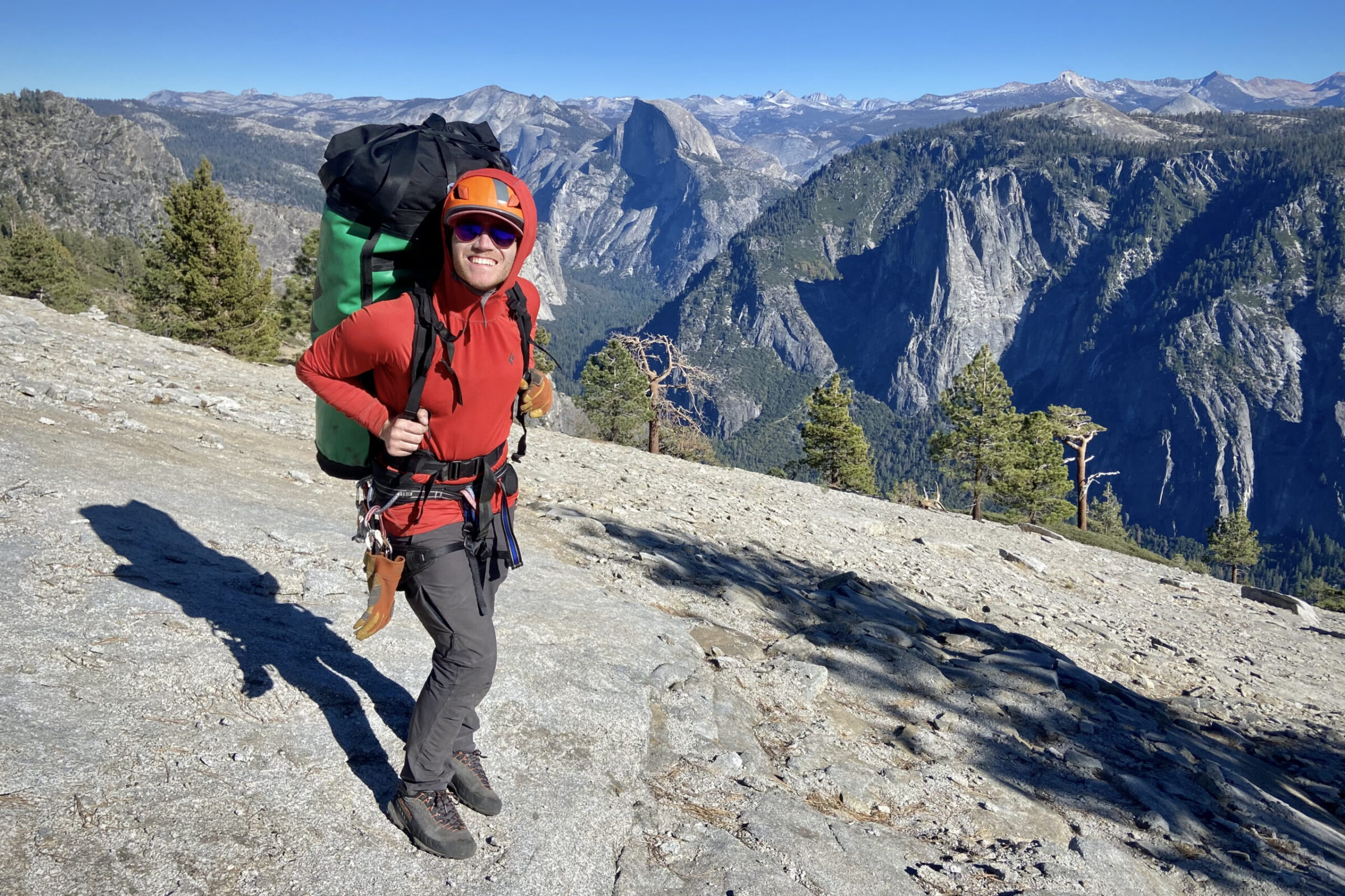
The bottom of a good hiking shoe will feature a firm and grippy outsole. Vibram is the most common manufacturer of outsoles, although some footwear companies make their own.
A sturdy outsole is a major feature that sets a hiking shoe apart from a sneaker or tennis shoe. On a wide range of surfaces from loose scree to slick rock, a good hiking shoe will maintain reliable traction.
Many hiking shoe soles are designed to specialize in certain types of terrain. If you’ll be regularly hiking through unstable surfaces like deep mud, you’ll want a sole with firm, large rubber lugs underfoot.
If you plan to do a lot of scrambling and smearing your feet on slabs of rock, a soft and sticky rubber sole with a flat toe edge is the way to go. Many entry-level hiking shoes will include a versatile sole that will perform fairly well on any hiking surface.
Some manufacturers have specific, niche approach shoes for technical rock scrambling on long approaches and walk-offs of big rock climbs. These shoes, like the La Sportiva TX4 in this guide, have super tacky rubber and midsoles designed for smearing and adhering to rocks.
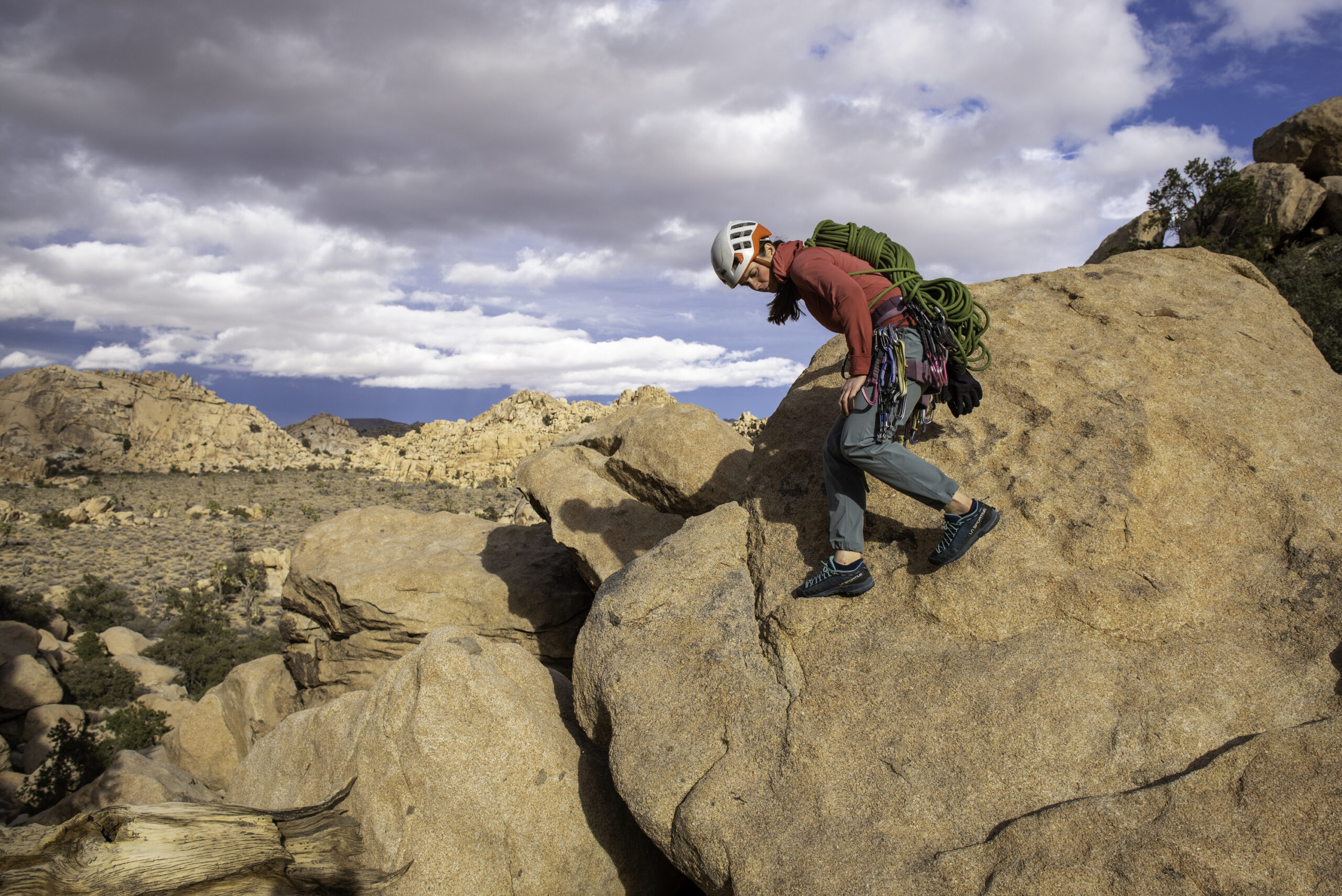
Breathability
A shoe’s breathability comes from the materials that make up its construction. Areas of open synthetic mesh and woven nylon will greatly increase breathability.
Meanwhile, large patches of leather and waterproof membranes like GORE-TEX will decrease breathability, but add significant durability. A breathable shoe will feel cooler and less sweaty over the course of a rigorous hiking day, but usually won’t last as long.
However, breathable shoes are more likely to soak through to your socks when hiking in the rain or trudging through puddles. Shoes billed as “waterproof” may feel hot and sweaty at times, but they also help keep mud and moisture from reaching your socks and feet.

Price & Value
Unlike their all-leather, high-top counterparts, hiking shoes are fairly inexpensive and rarely cost more than $200. However, there is value in longevity, and a comfy breathable pair with breathable synthetic uppers just isn’t going to last as long as a durable leather beater. Shoes with a waterproof breathable liner like GORE-TEX will also cost more. Note that many of the shoes on our list are available in a waterproof version for a little bit more money.
Budget
The Merrell Moab 3 is the least expensive shoe we tested and our top pick for the best budget hiking shoe. It isn’t waterproof and has a combination of Nubuck leather and mesh for its upper. The Moab 3 is on the heavy side, and they are designed strictly as hiking shoes, not for trail running.
While they have a wide, accommodating fit that isn’t for everyone, especially those with narrow feet. The Oboz Sawtooths ($135) have a similar design and are a worthy alternative if the Moab 3s don’t quite fit. Additionally, the Merrel Moab Speed 2s offer a lighter, more breathable alternative for just $140
Mid-Tier
Most of the shoes on this list cost $140-180, and our favorite shoes fall in this tier. If this is your price range then the debate should be between the Hoka Speedgoat 6 ($155) and the Altra Lone Peak 9 ($140). Both are trail runner crossovers built to go long distances but offer very different fits and features.
If you’re looking for a shoe that fits like your road running shoes, but has more cushion is more durable for the trail, then the Speedgoat 6 is the way. The Altra Lone Peak 9 is a zero-drop shoe with a wide forefoot so your toes can fully splay out. They are well regarded among thru-hikers, but take some getting used to, as they work your calfs a bit more than a show with moderate heel-to-toe drop.
Premium
The HOKA Anacapa 2 Low GTX ($180) and the Adidas Terrex Free Hiker GORE-TEX 2.0 Low ($180) are the most expensive shoes on the list. The extra cost is obviously attributed to the GORE-TEX liners. While not as breathable as having no waterproof liner at all, a GORE-TEX liner is still the industry standard in waterproof, breathable membranes.
Companies who want to use GORE-TEX in their shoes need to have each model thoroughly tested, evaluated, and then approved by GORE-TEX. This process and the materials all add to the cost of the shoes. Our favorite waterproof shoe is the Scarpa Rush 2 Pro GTX ($179) and it’s also one of the more durable shoes we tested, so if you’re looking for something with a longer lifespan, it’s a good choice.
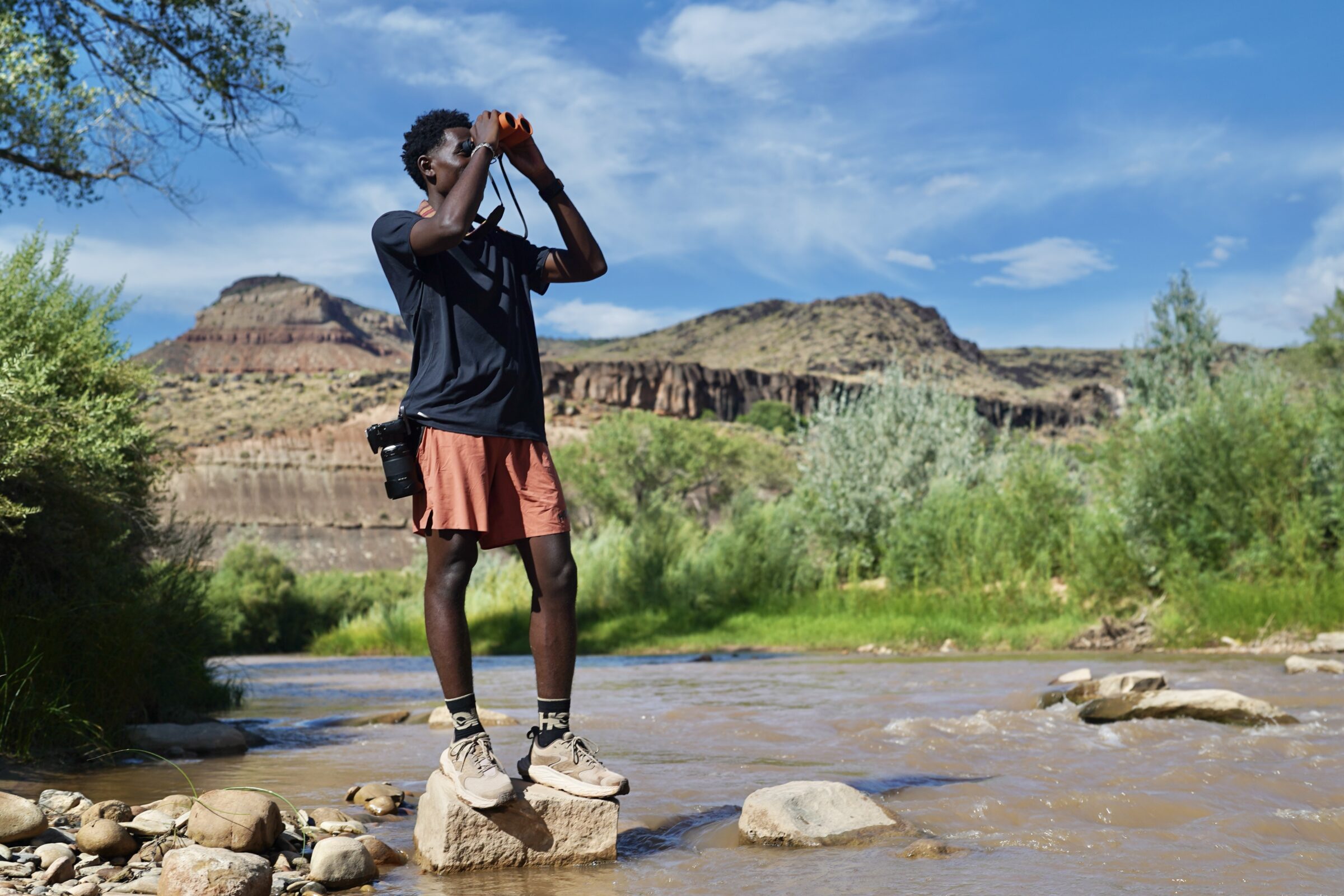
Frequently Asked Questions
The best hiking shoes are the ones that fit your feet comfortably and allow you to enjoy your time on the trail. When combing through the options, your first priorities should be fit and comfort.
Durability, support, and traction are important, too, but ultimately none of that matters if the shoes hurt your feet.
Also, no single pair of hiking shoes will be the very best for every application. The materials, design, and tread pattern will add up to a set of strengths and weaknesses in every shoe.
The current momentum in hiking footwear has shifted away from bulky ankle-high boots in favor of nimble, lower-cut hiking shoes. Hiking boots are heavier, and weight carried on your feet can feel very uncomfortable at the end of a full day. Switching out a 4-pound pair of boots for a 2-pound pair of hiking shoes can make a huge difference in your performance.
Also, many hiking boots have very stiff soles that keep the foot from flexing properly. Many boots are constructed with nonbreathable materials, meaning that your feet are more likely to get sweaty and form blisters. That said, hiking boots can be a great option for those who prefer lots of ankle stability or underfoot stiffness.
Hiking shoes are generally similar in shape to a pair of trainers or tennis shoes. The difference is that hiking shoes are built with durable materials and feature an outsole that is made to grip dirt, rocks, and mud. Compared to boots, hiking shoes feel light, nimble, and somewhat less supportive.
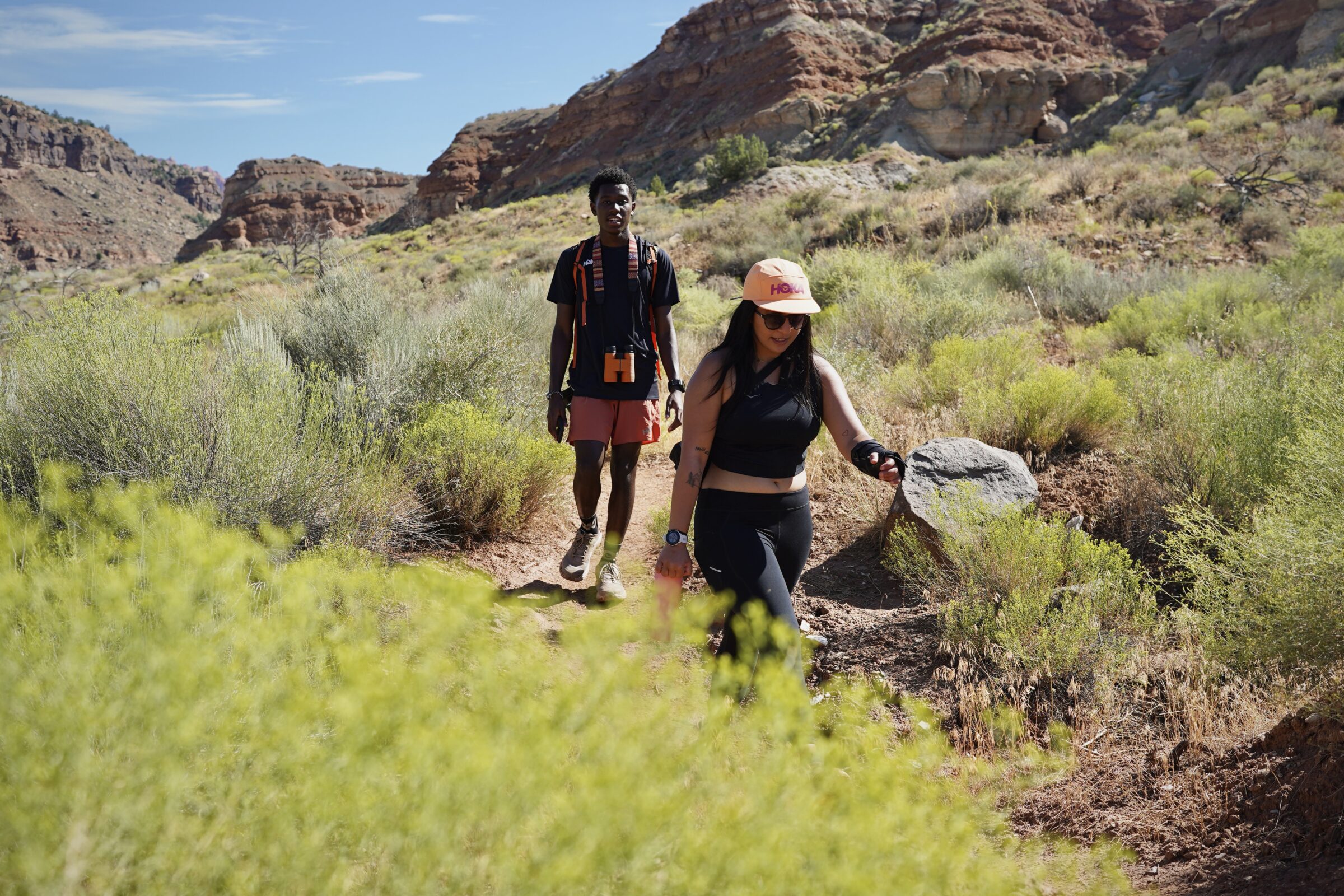
That depends. Keep in mind that no pair of hiking shoes is entirely water-resistant. Although some are marketed this way, full submersion in a puddle for more than a few seconds will soak through just about any pair of hiking shoes. Also, because they are low cut around the ankle, water is prone to getting in at the top of the shoe anyway.
Still, waterproof shoes do include membranes, like GORE-TEX, that can keep a significant amount of moisture out. When walking through dewy grass or muddy trails, waterproof shoes will keep your socks and feet drier than non-waterproof shoes.
Shoes with waterproof membranes are less breathable. If you will be hiking in hot and dry areas, you’ll probably feel more comfortable in non-waterproof shoes.
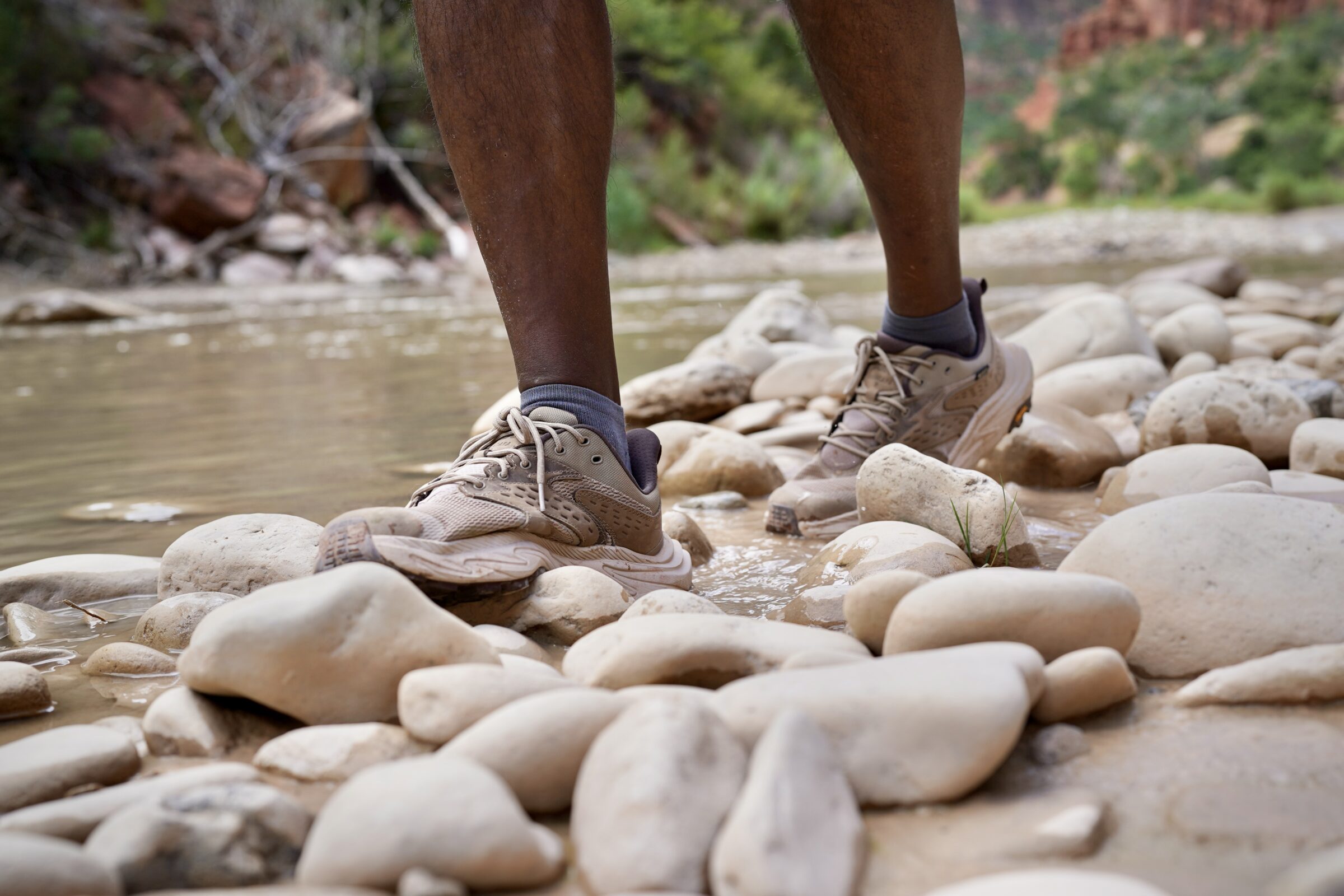
For the most part, sneakers are designed to perform on artificial surfaces such as asphalt or cement. Many sneakers have flimsy soles and lack the appropriate level of support that is needed for hiking on uneven terrain. Additionally, sneakers are less likely to hold up to the abrasion and wear that is common while hiking on rough trails.
If you plan to mostly walk on flat trails in urban parks or backyards, you’ll probably be just fine with sneakers. However, for hikes of any significant length — and especially backpacking — hiking shoes are a much better choice.
Barefoot shoes are designed to allow your foot to flex naturally with every step. Thanks to their thin and flexible materials, barefoot shoes let you feel the texture of the trail in the soles of your feet.
With each step, the tissues of your feet directly respond to the trail, conforming and contracting as needed. As the name suggests, the experience is similar to walking barefoot.
While barefoot shoes are known for helping hikers and runners develop strong feet, they do take some getting used to. If you have been hiking in boots or hiking shoes, the transition to barefoot shoes will need to be gradual. If you do too much barefoot shoe hiking too soon, you may experience discomfort or quickly develop an injury.
Barefoot shoes lack insulation. They also will not protect your feet from sharp objects underfoot and may be quick to wear out. While some experienced hikers have made the transition to barefoot shoes, we generally do not recommend them to beginners.


The Best Hiking Boots of 2025
If you’re looking for the best hiking boots, look no further. We’ve tested dozens of hiking boots over hundreds of miles to help you stay happy and comfortable on the trail.

The Best Hiking Boots for Women of 2025
We tested the best hiking boots for women from Scarpa, Merrell, Salomon, La Sportiva, and more to help you find the best option for your needs and budget.
